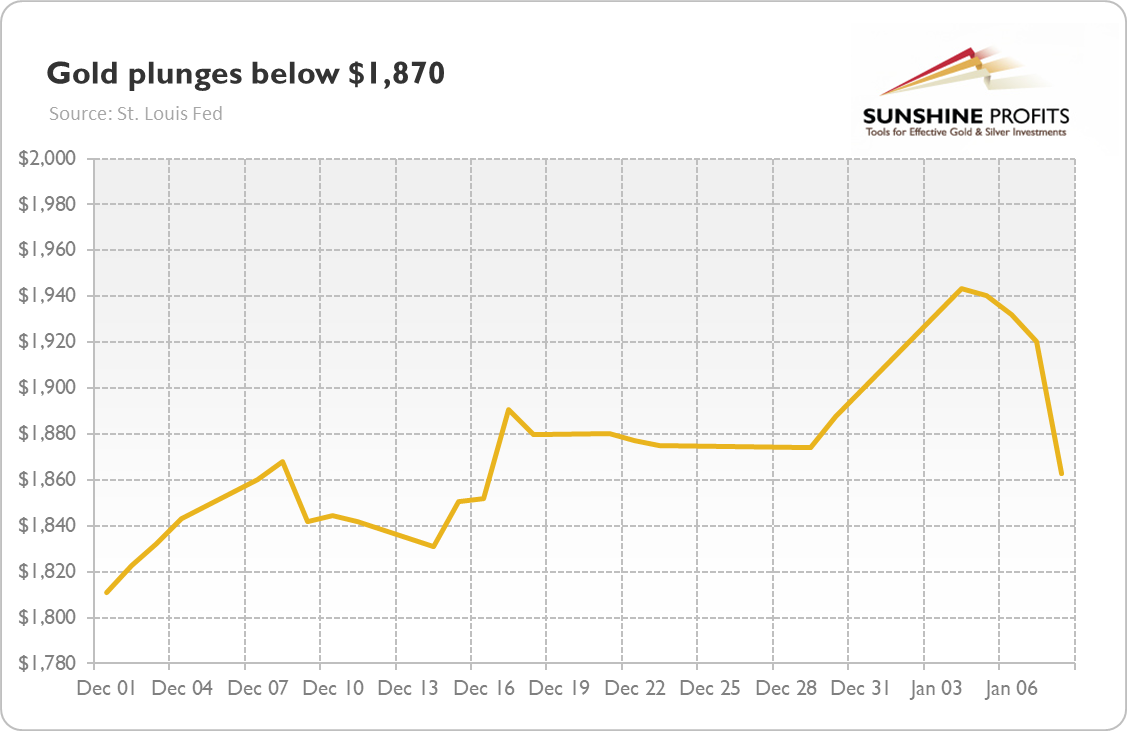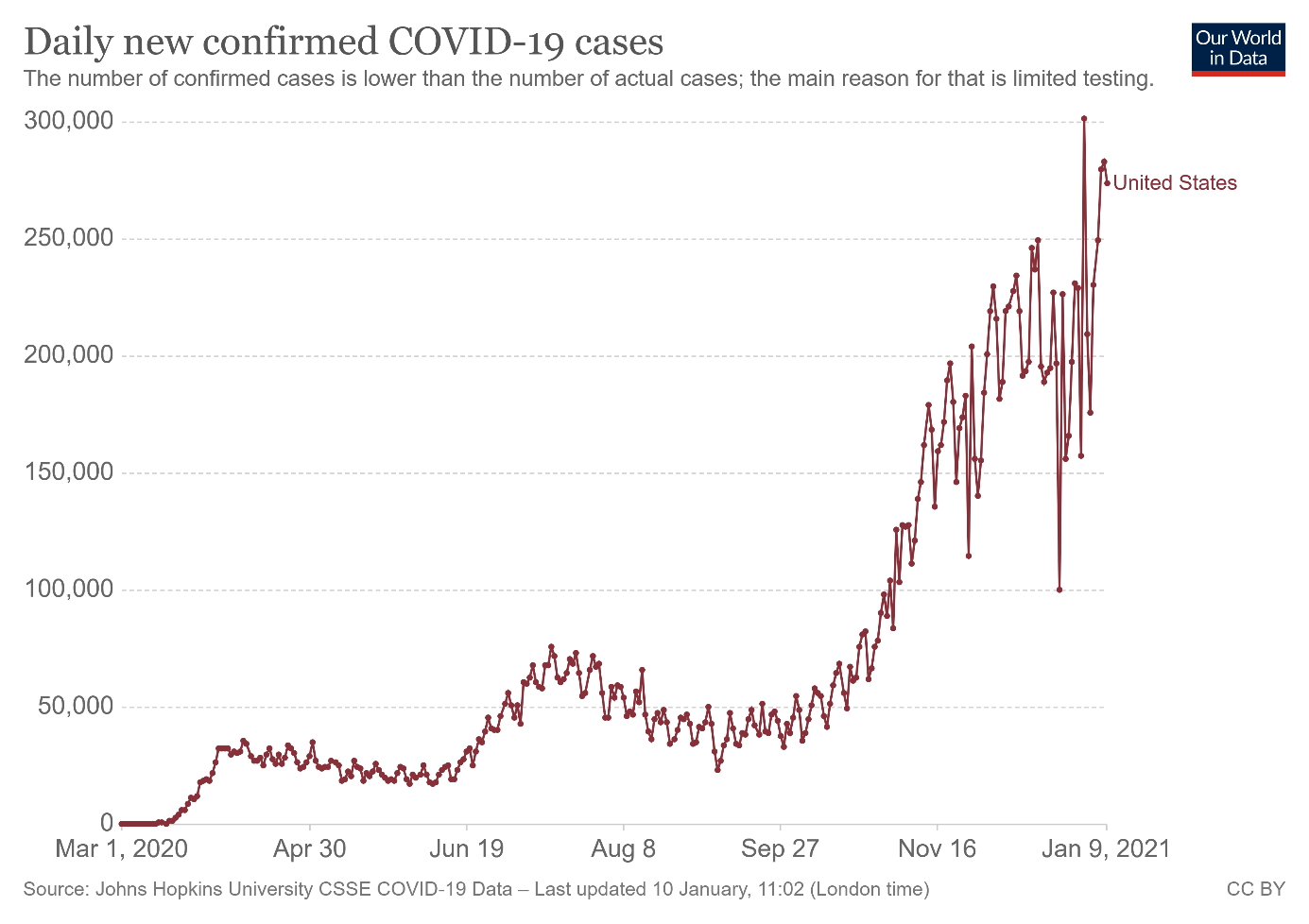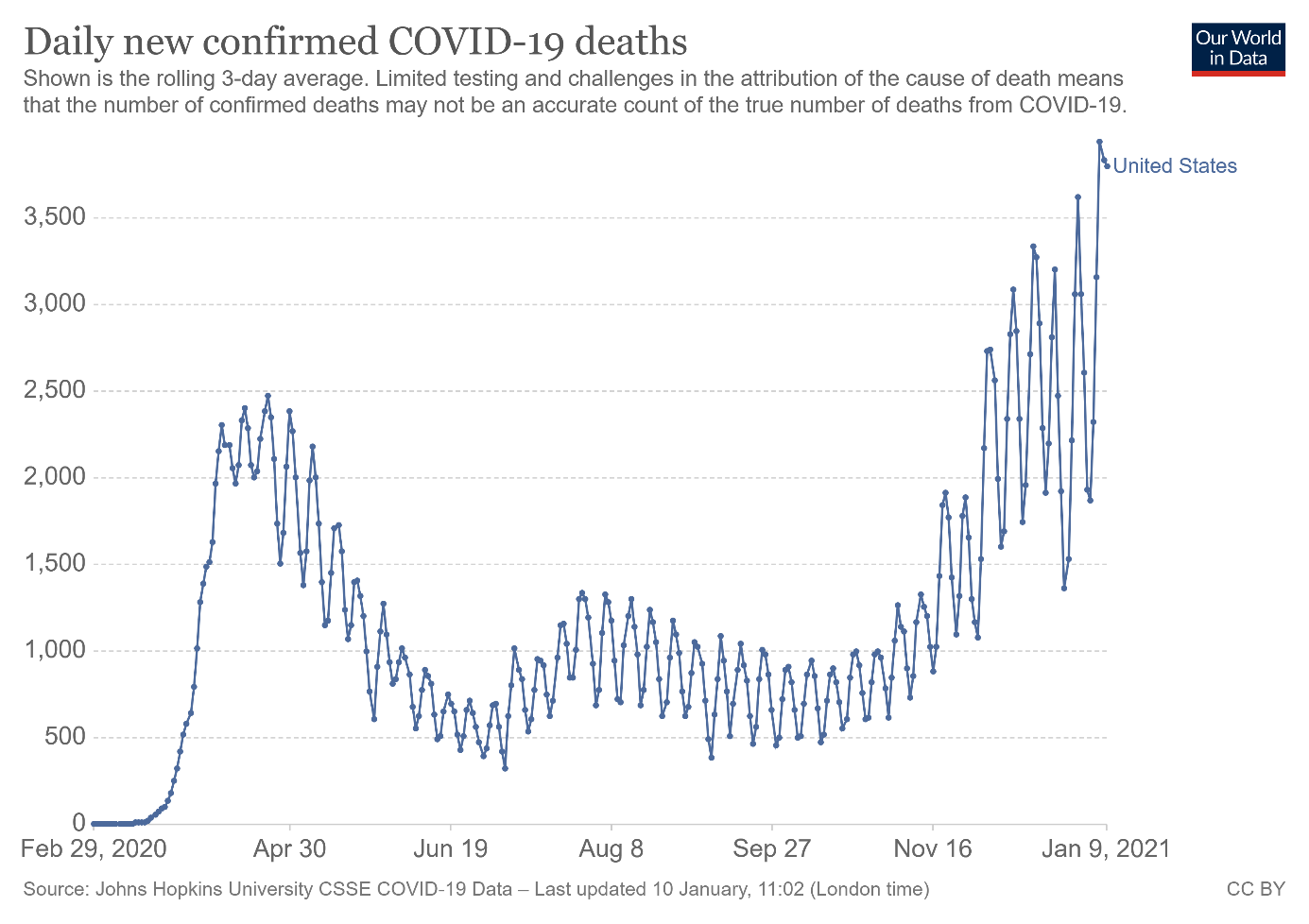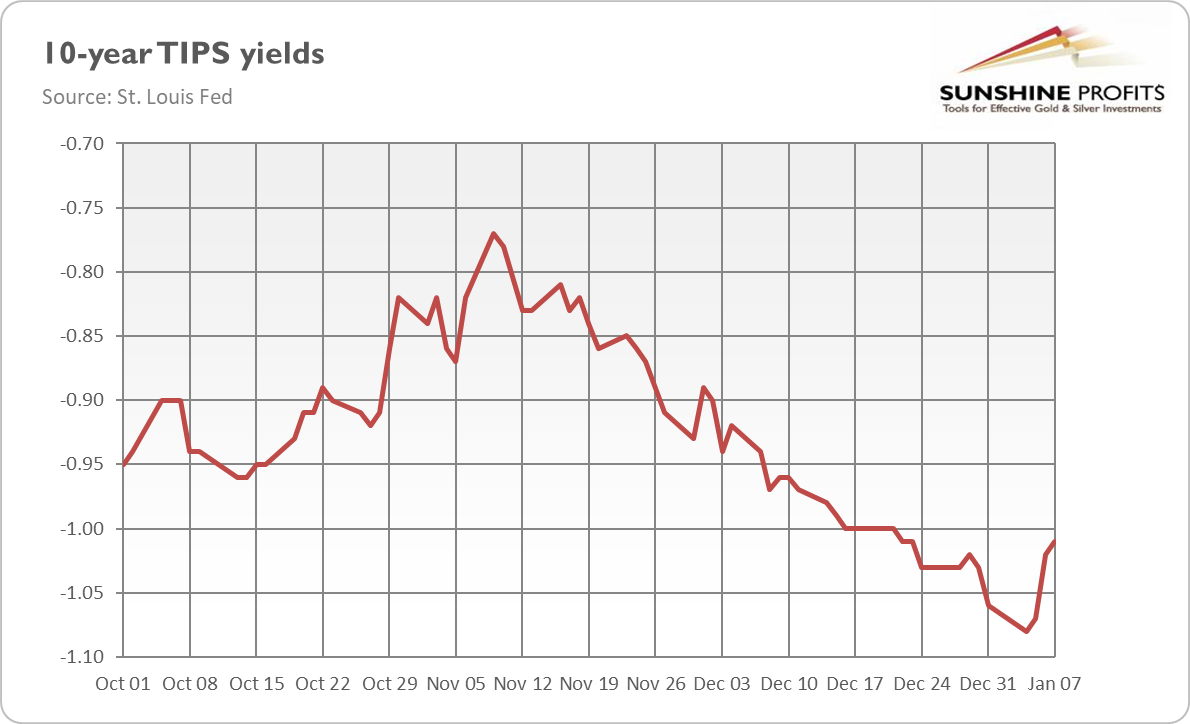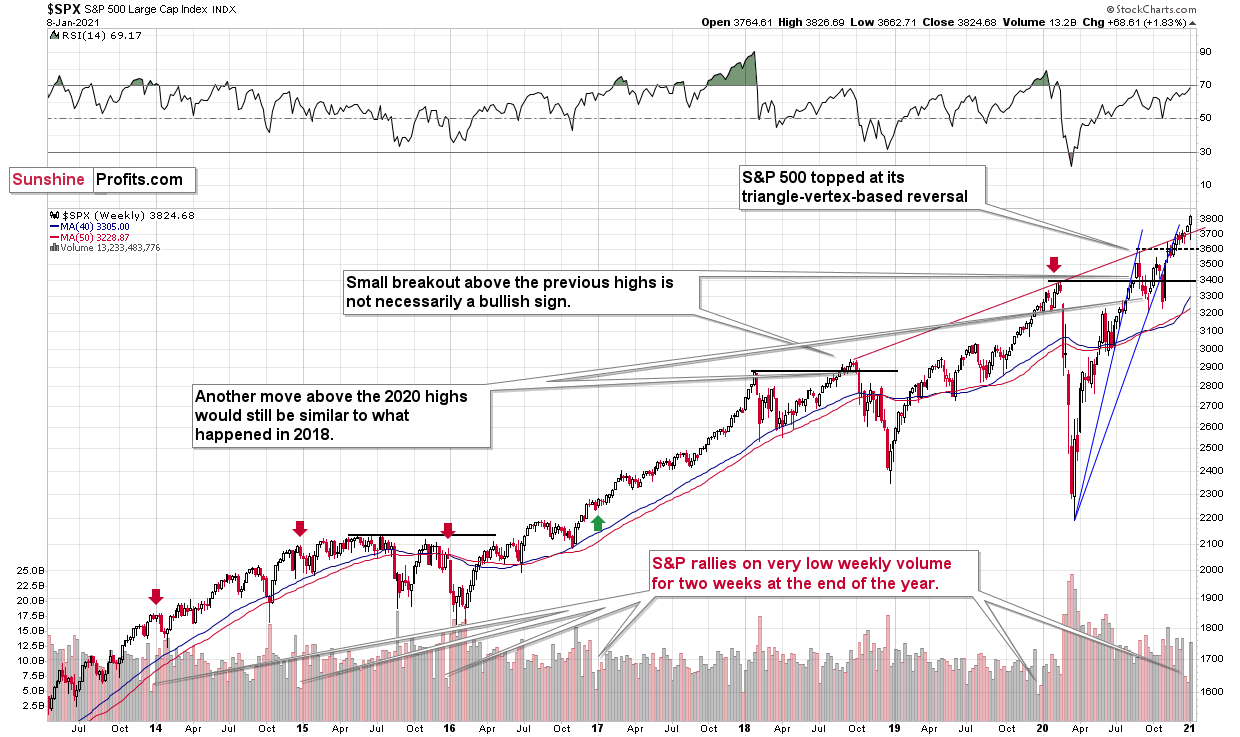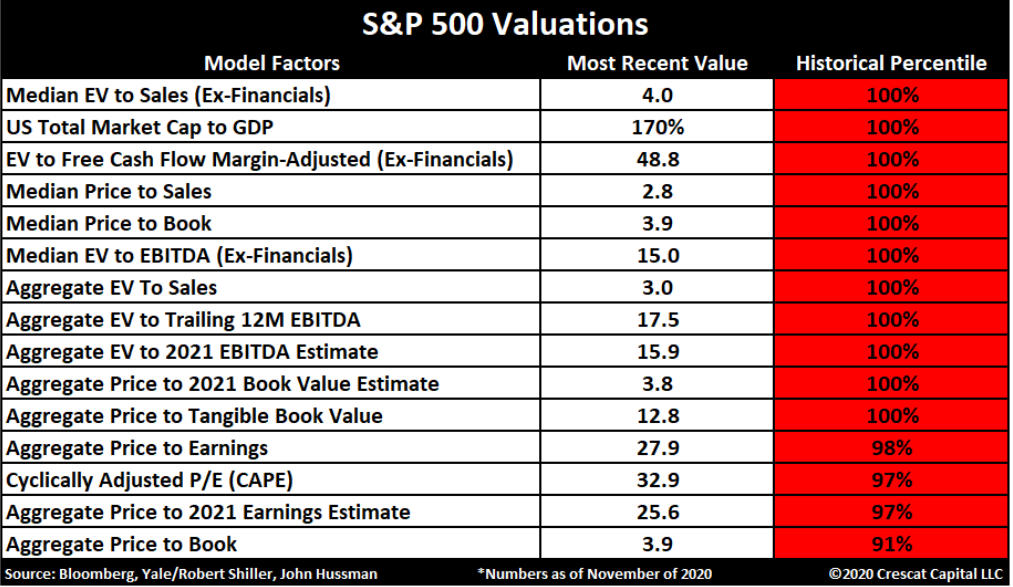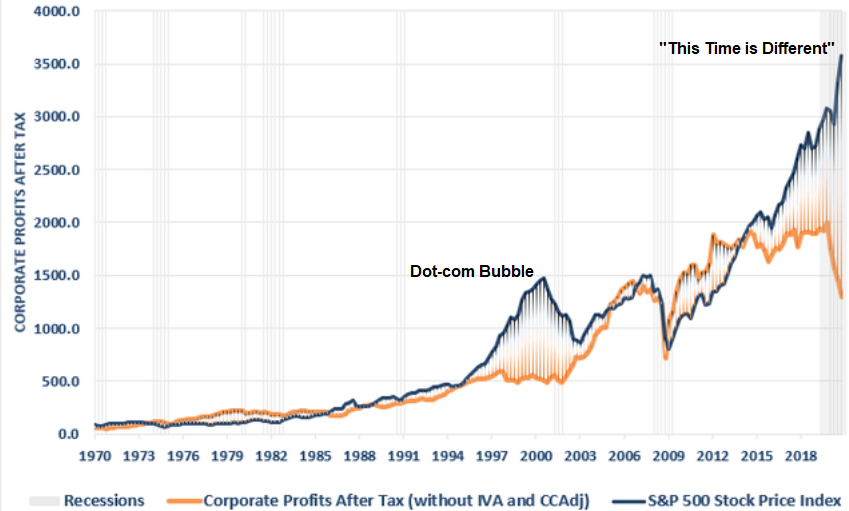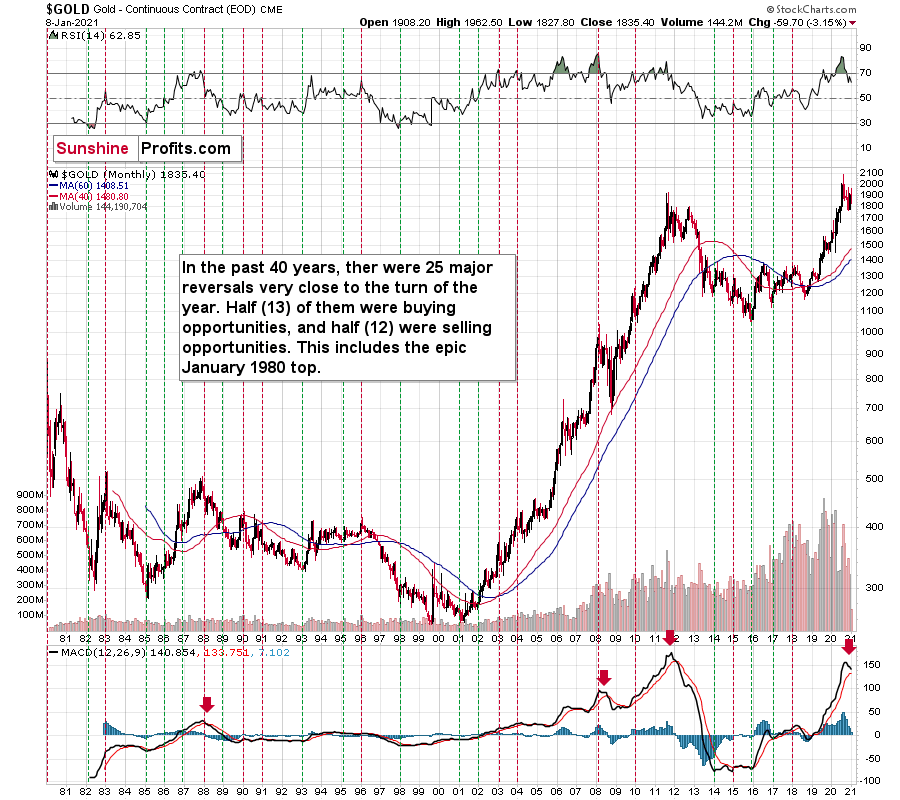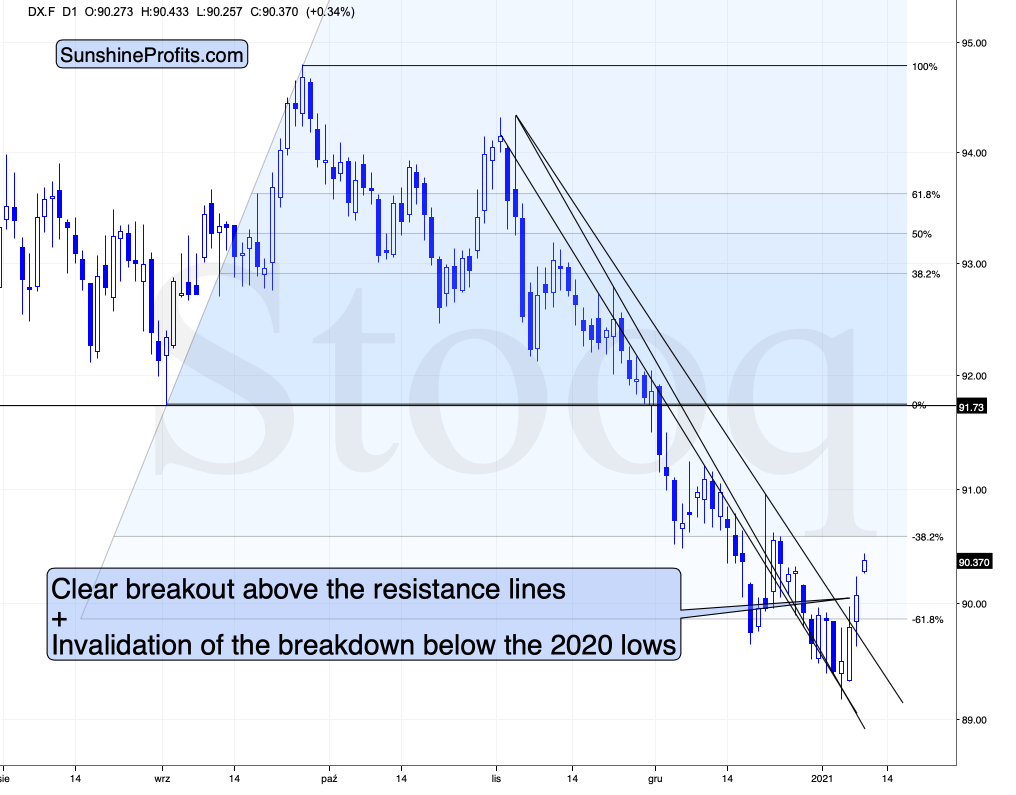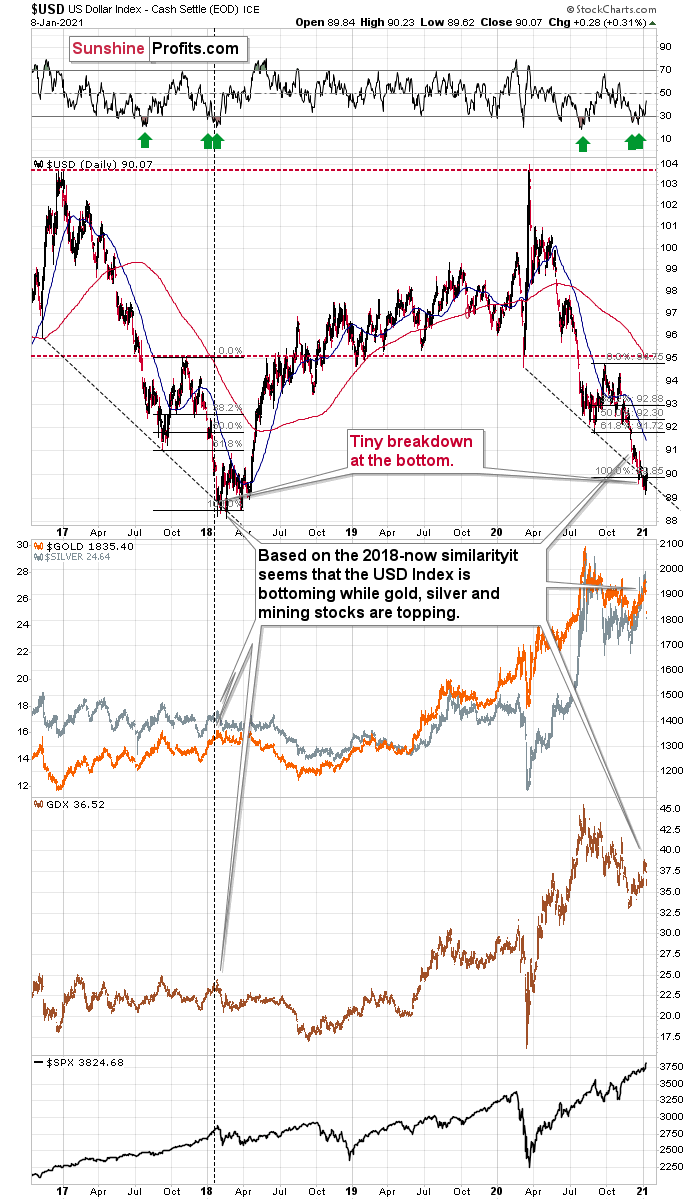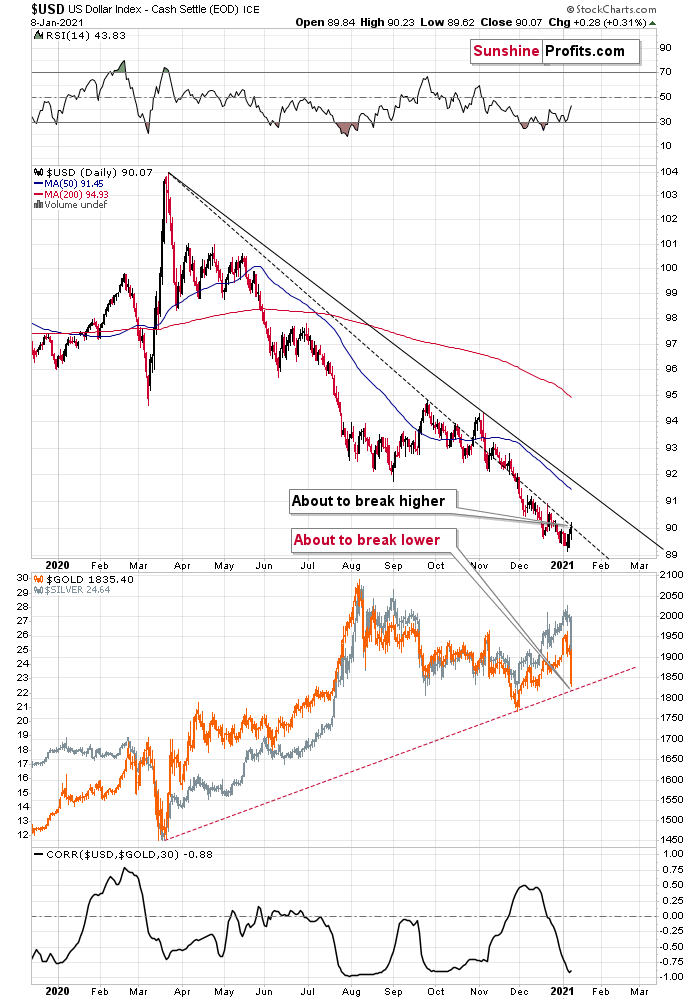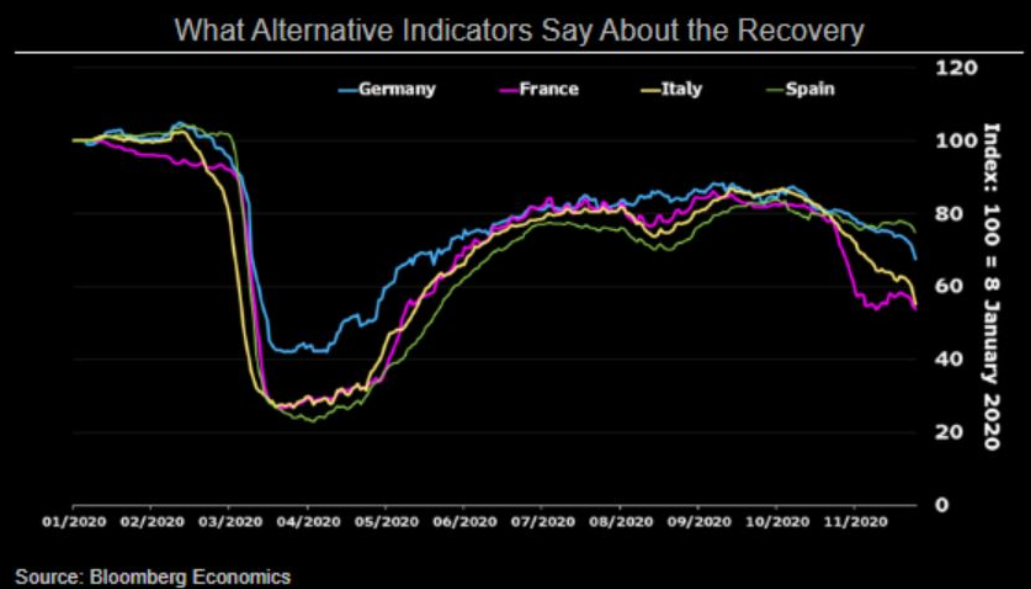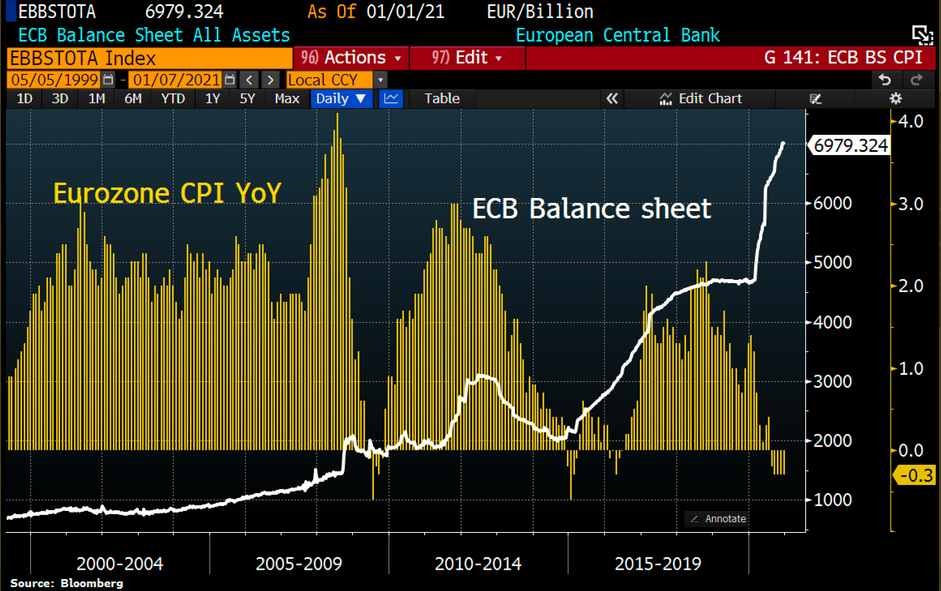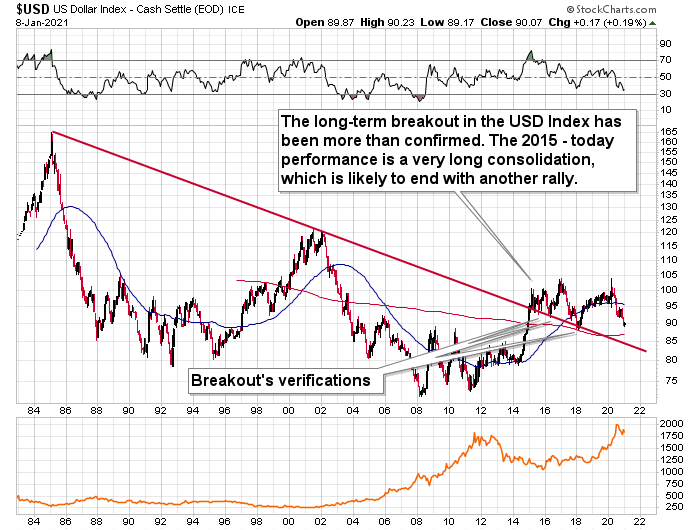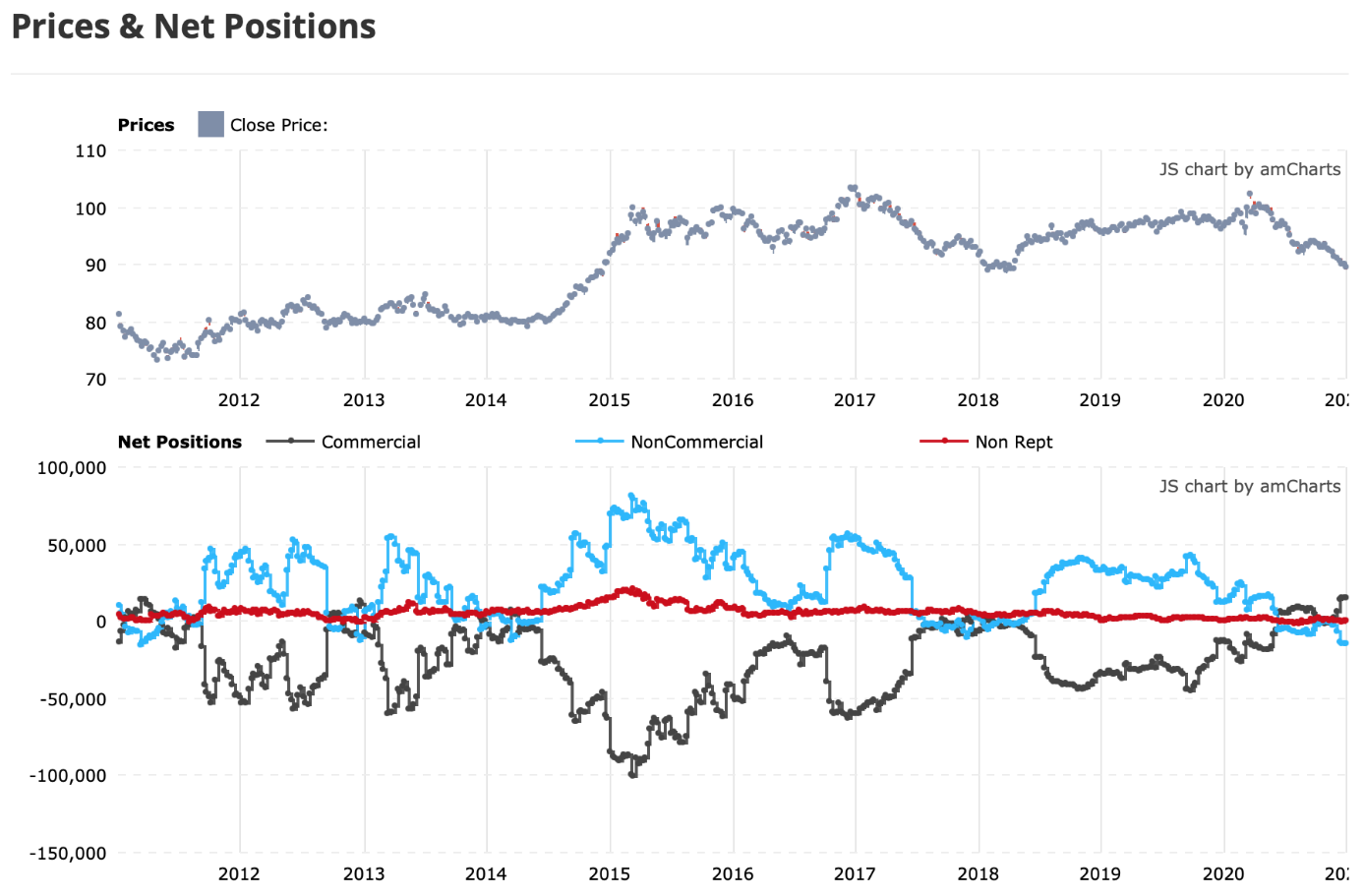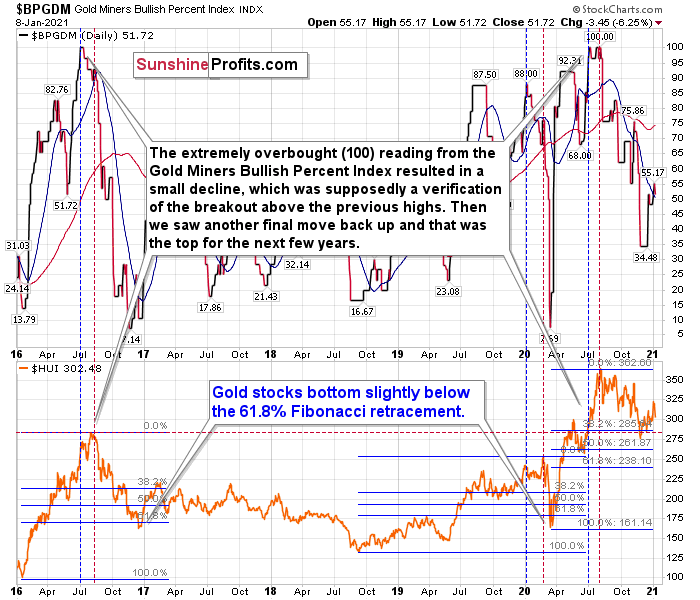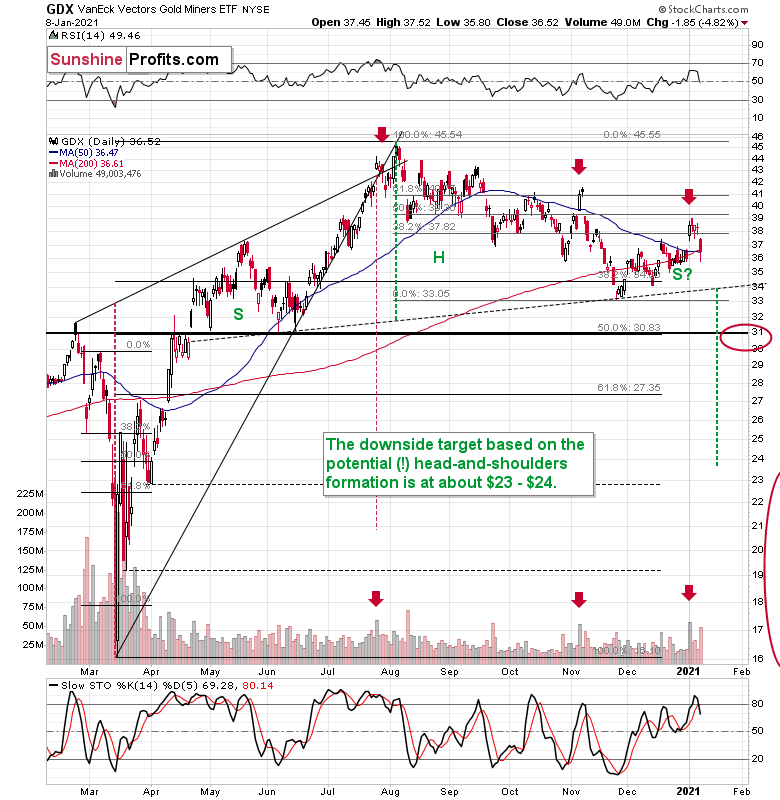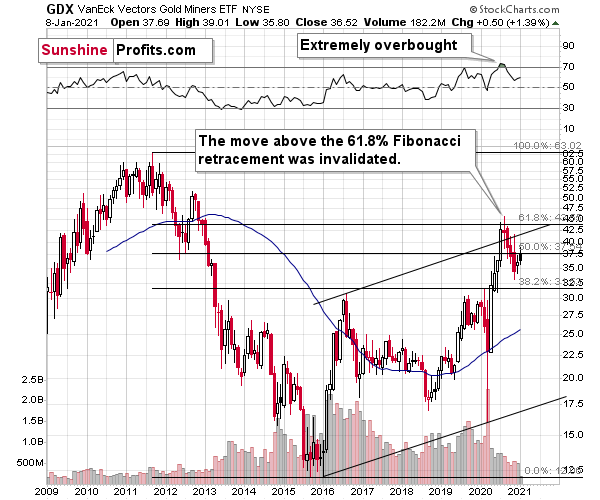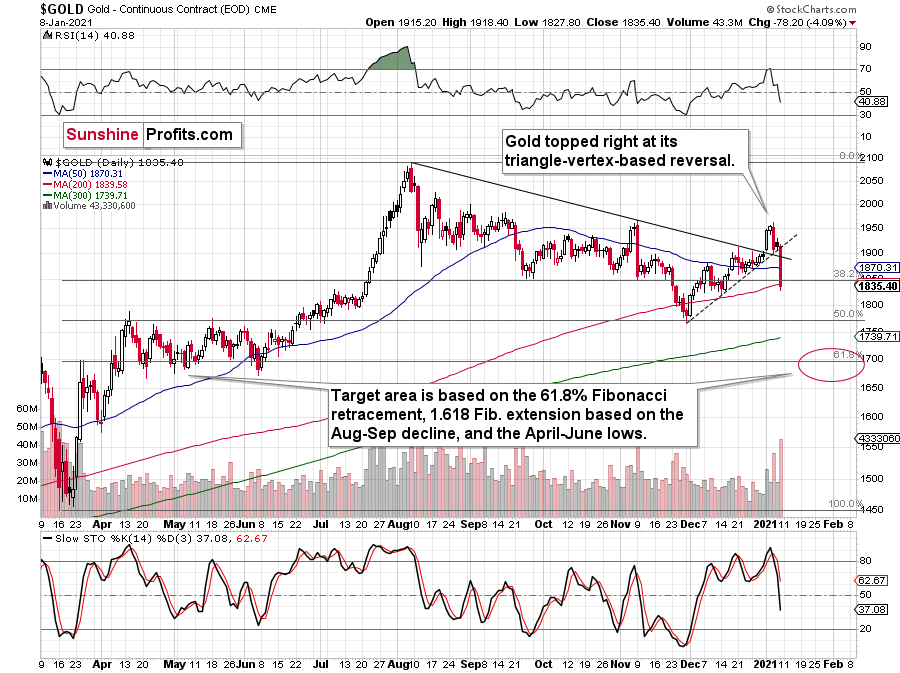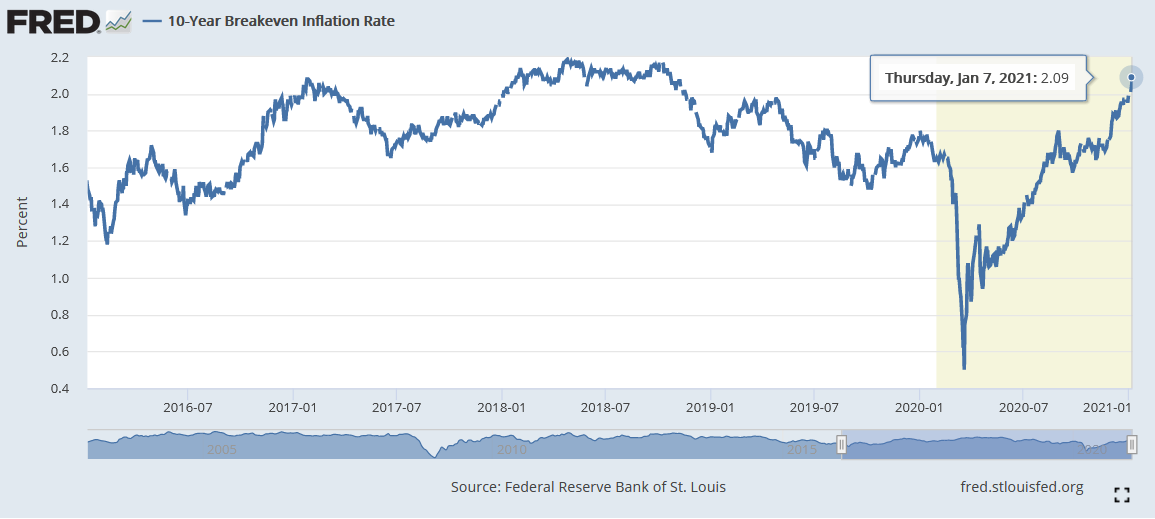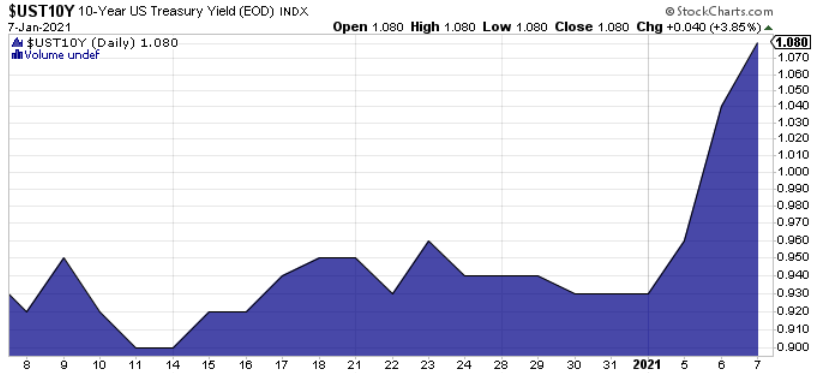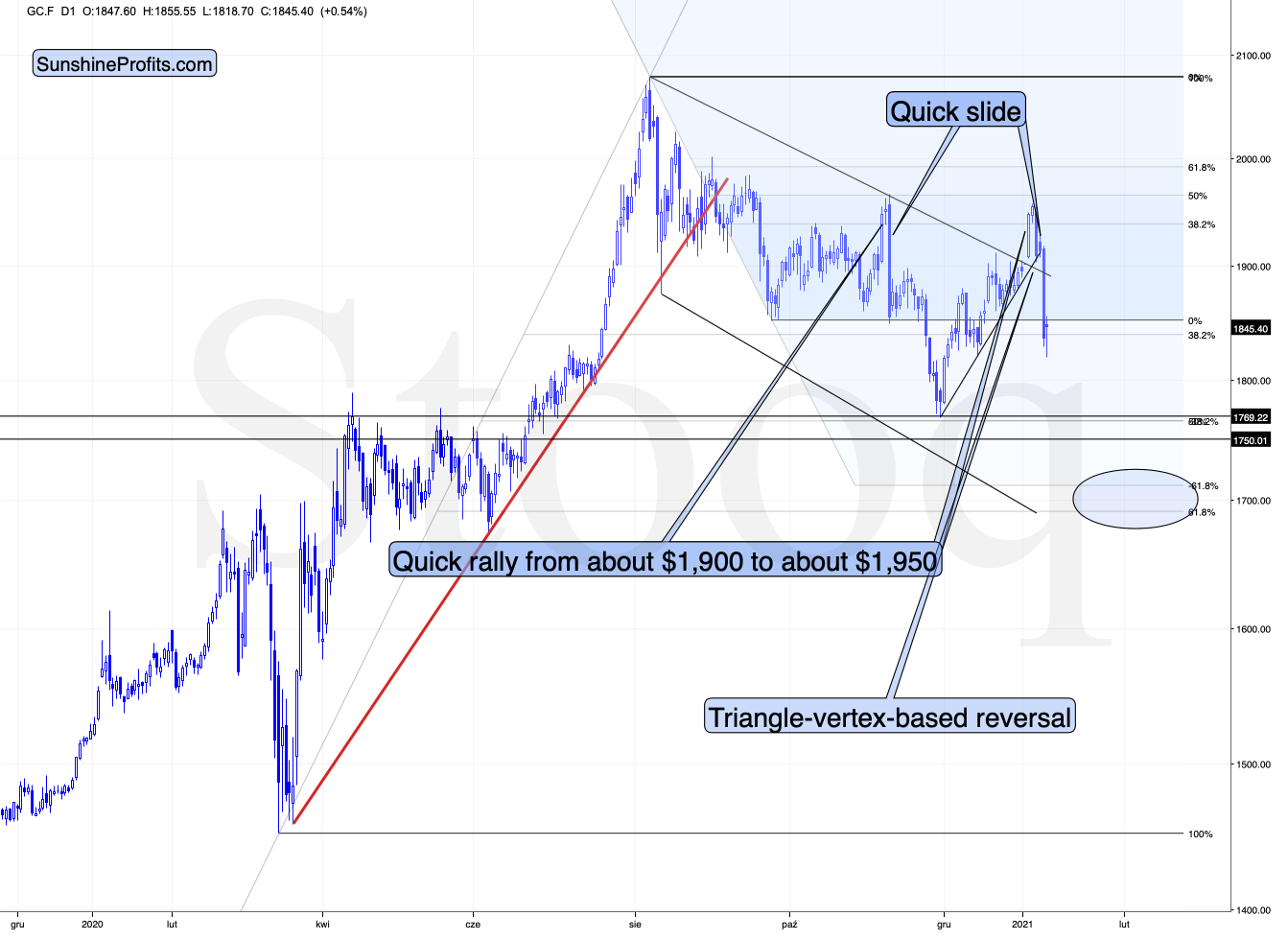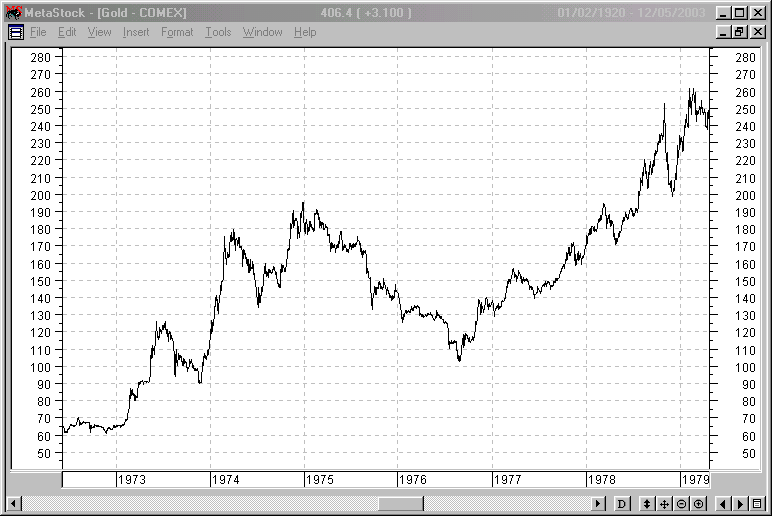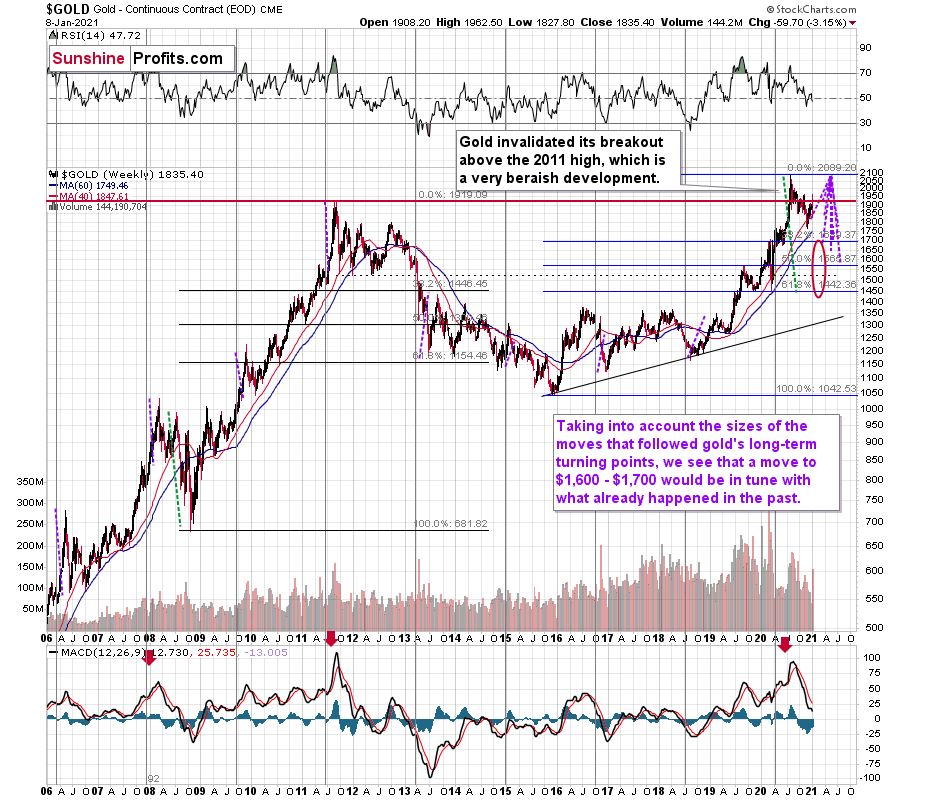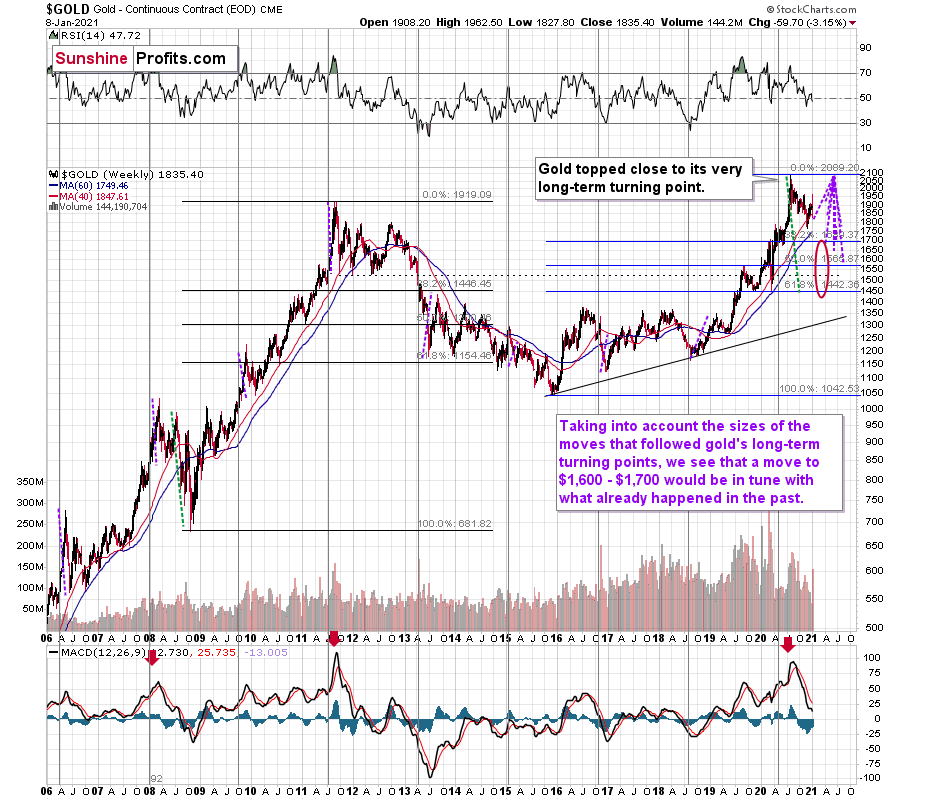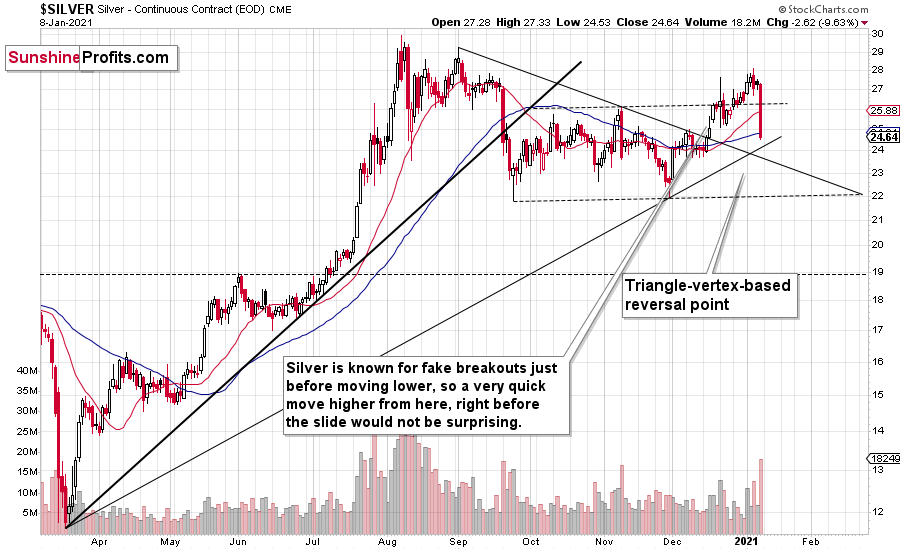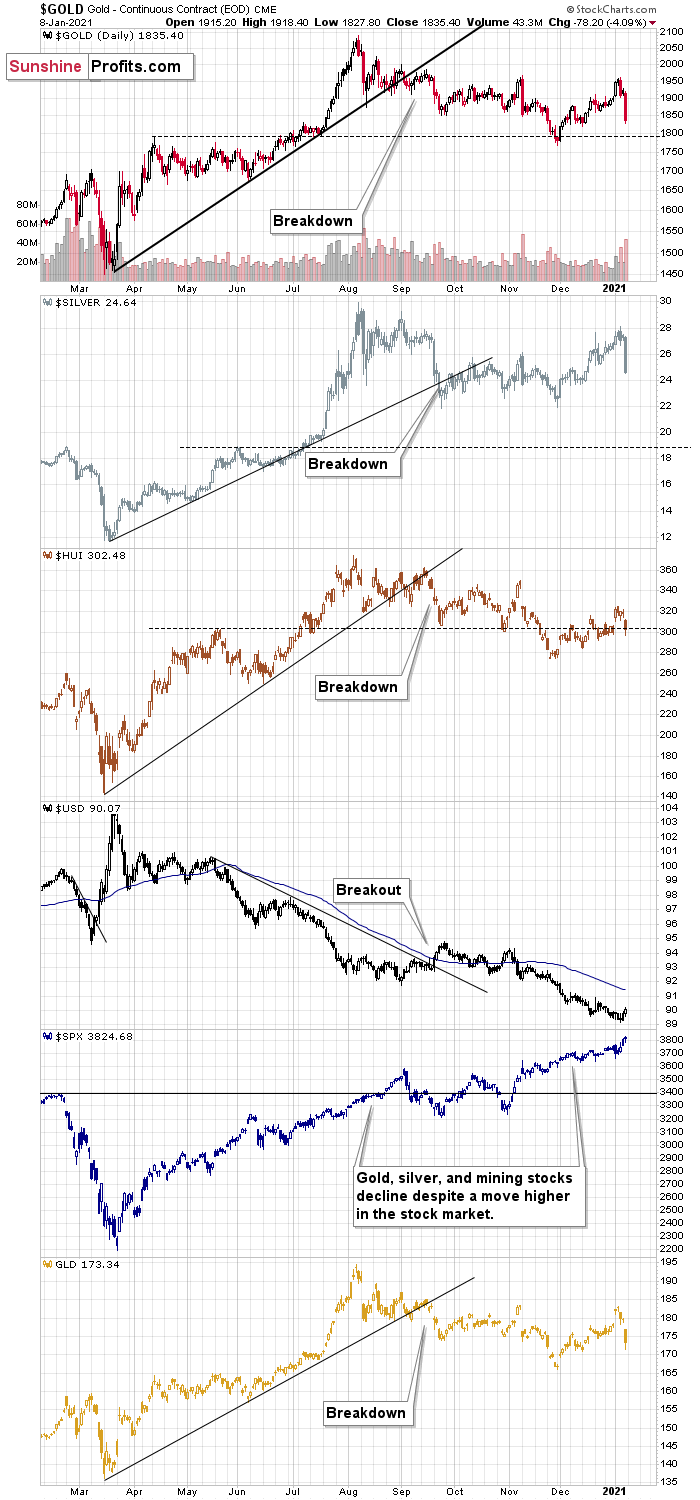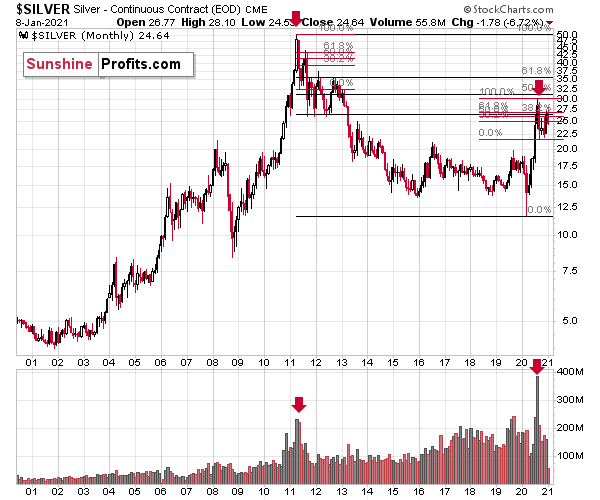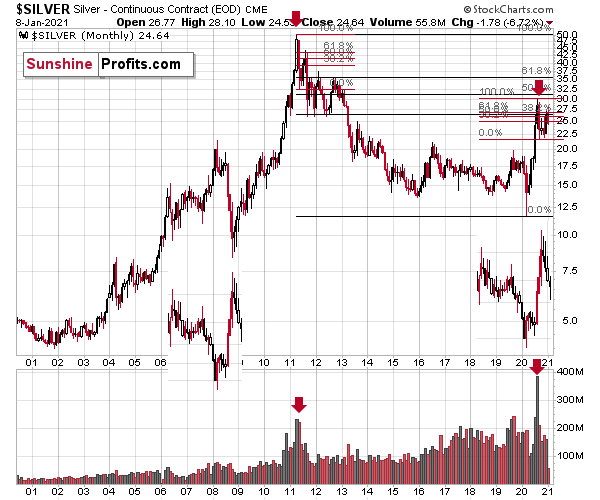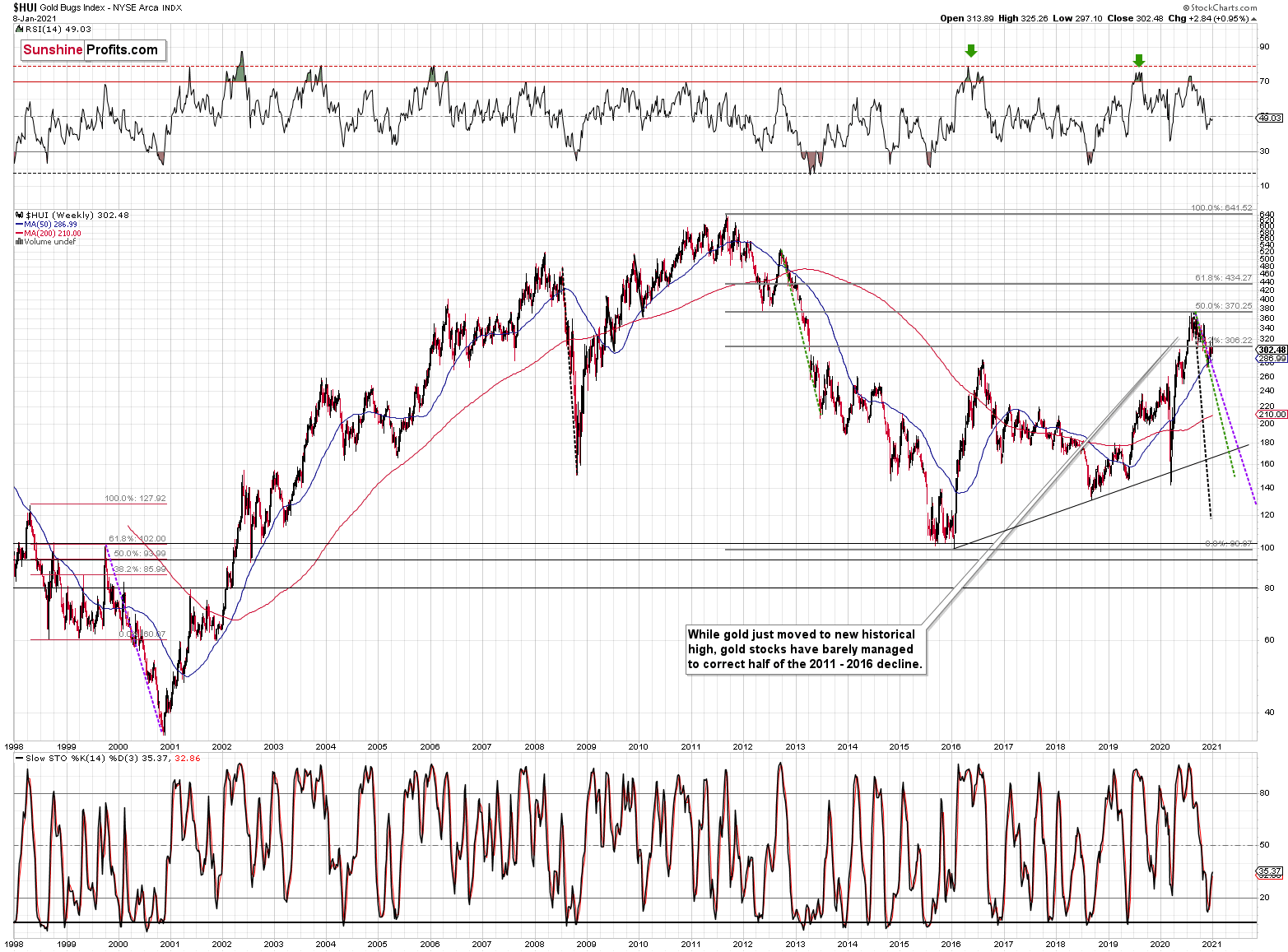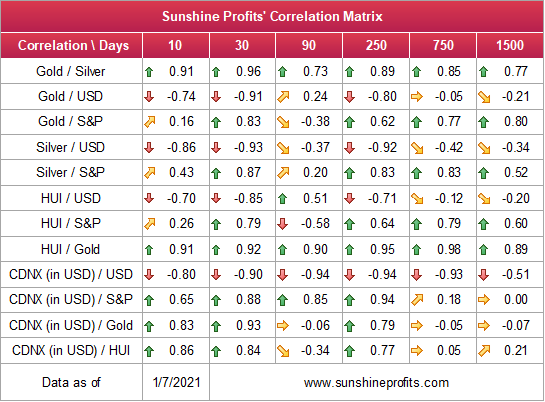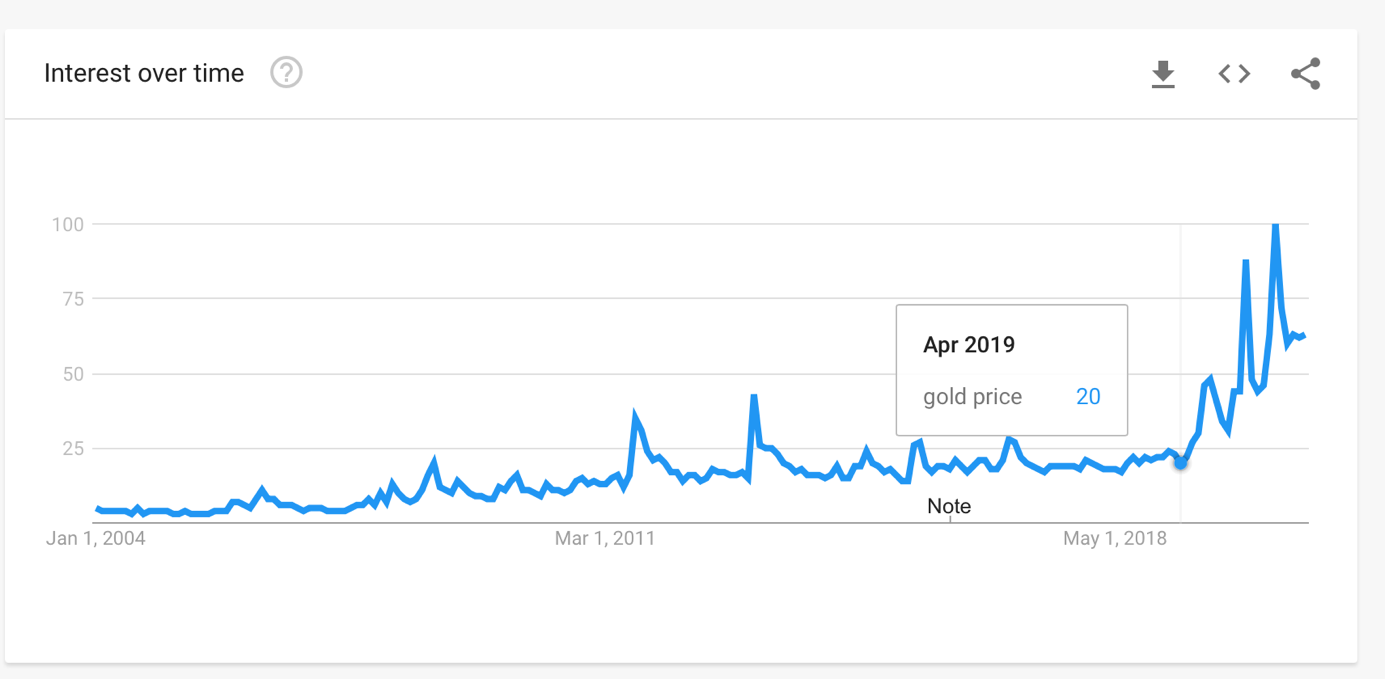Briefly: in our opinion, full (300% of the regular position size) speculative short positions in mining stocks are justified from the risk/reward point of view at the moment of publishing this Alert.
Welcome to this week's flagship Gold & Silver Trading Alert. As we’ve promised you previously, in our flagship Alerts, we will be providing you with much comprehensive and complex analyses (approximately once per week), which will usually take place on Monday.
Predicated on last week’s price moves, our most recently featured outlook remains the same as the price moves align with our expectations. On that account, there are parts of the previous analysis that didn’t change at all in the earlier days, which will be written in italics.
Let’s start with a bigger discussion about the impact that U.S. politics can have on the price of gold.
Last week was quite peculiar, to say the least. First gold soared to almost $1,960, but then its price (London P.M. Fix) plunged to $1,863 on January 8, as the chart below shows.
Figure 1
This is quite strange (and bearish) behavior, given what happened last week. First, there were violent pro-Trump protests in Washington D.C. The rioters stormed the U.S. Capitol. During these riots, five people died. Given the chaos in the capital, gold, which is a safe-haven asset, should shine.
Second, the December Employment Situation Report came out. It turned out that the nonfarm payroll employment declined by 140,000 last month. The numbers fell short of expectations, as the pundits expected that the U.S. economy would add 50,000 jobs. The contraction in the nonfarm payrolls means that the winter wave of the COVID-19 pandemic hit the U.S. labor market rather significantly.
Third, despite the rollout of vaccinations (which is rather sluggish), the epidemic in the U.S. is taking its toll. The number of daily new cases of the coronavirus is above 250,000, the record high, as the chart above shows. So, we see the impact of the winter holidays showing up in the data.
Figure 2
Rioting will also not help in limiting the spread of the coronavirus. Furthermore, hospitalizations and deaths are also rising. The past week saw the first time the U.S. reporting more than 3,900 deaths in a single day, as the chart below shows.
Figure 3
Lastly, both Democratic candidates won the runoffs in Georgia, which means that Democrats took control over the Senate. The unexpected blue wave raised expectations for higher taxes and larges fiscal deficits, which should be positive for gold.
These factors should have been bullish for gold and they should have made the price of the yellow metal rally, but they weren’t and they didn’t. It seems that investors generally welcomed the blue wave and focused on a positive side of that development, or it might have been the case that the gold market was reacting to technical developments, not the fundamental ones. In any case, we can see the replay of the 2016 presidential election when everyone expected that Trump’s victory would be bad for the equity markets and positive for the precious metals market. But back then shares soared while gold plunged. We are currently witnessing something similar. Everyone thought that a blue wave would be the best scenario for gold, but the yellow metal dropped again.
Why? Well, maybe it was just a “buy the rumor, sell the fact” phenomenon. Or maybe investors just don’t care about the long-term consequences of larger fiscal stimulus, such as rising public debt. Instead, they assumed that more government spending would accelerate GDP growth. This is why the real interest rates rose (see the chart below), which pushed the gold prices lower.
Figure 4
Another issue is that when Trump didn’t support the riots, investors assumed that there will ultimately be a peaceful transition of power and started to sell safe-haven assets such as gold. With Democrats taking control of both the White House and the whole of Congress, investors increased their risk-appetite, which created downward pressure on gold prices.
Moreover, the minutes of the latest Federal Open Market Committee (FOMC) meeting published last week indicate that further monetary easing is not likely in the very near future.
However, sooner or later the Fed will have to step in. The worsening condition of the U.S. labor market and rising bond yields will prompt the central bank to provide further accommodation. After all, the main task of the central banks is to provide the governments with fiscal room. And at some point, investors will start to worry about the rising fiscal deficits and public debt.
So, as long as the real interest rates are rising, gold will be in trouble. But at some point the rates should stabilize, or they could even decline again – especially if inflation emerges – which would help the gold prices.
All in all, there are multiple fundamental reasons why gold is likely to soar in the upcoming years. However, even the most profound bull markets can’t move up in a straight line, and some corrections will likely take place. After the big rallies, we will probably witness significant corrections, and in the case of the precious metals market, one is long overdue.
To clarify, the significant correction in the precious metals market is already underway, but it seems that it’s not over yet, and it’s probably before its biggest and most important part.
Triggers for the decline in the precious metals market are not necessary – the market might collapse on its own or as a result of some lone random trigger that normally wouldn’t cause any major action. However, a trigger would speed things up. The less likely trigger might come from the general stock market – after all, it fell sharply together in the first half of this year.
S&P 500 (SPX) Signals
Even amidst the S&P 500’s upward inertia, the precious metals were still cut off at the knees. Over the last 30 days, correlations between gold and the SPX, and silver and the SPX, have been 0.83 and 0.87 respectively.
However, as I warned:
A decline in stocks is not required for the PMs to decline. However, a break in the former could easily trigger a sell-off in the latter. And as history has shown, silver and the miners will be the hardest hit.
And while the recent break gave bullion bulls a small dose of short-term reality, the S&P 500 could be next in line.
Despite rising above its triangle-vertex-based reversal point, the U.S. equity benchmark’s RSI (Relative Strength Index) is just below 70 (signaling overbought conditions). And just like we saw back in 2020 – when the S&P 500’s RSI approached 70 – it preceded two meaningful declines.
Please see below:
Figure 5 – S&P 500 Index
In addition, declining end-of-year volume (during the last two weeks of 2020) remains a bearish indicator. And while a drawdown has yet to materialize, current price action follows the 2020 playbook: initially, investors ignored the bearish implications, only to suffer through a significant sell-off soon after.
The key takeaway?
The break in correlations proves that the precious metals don’t need equities to lead their decline. However, a drawdown of the former will likely accelerate the move lower for the latter.
Regarding fundamentals, valuations are also ringing alarm bells.
If you look at the chart below, you can see that 11 of 15 valuation metrics either equal or exceed the dot-com bubble (For further context, the data was compiled in late November; and with the SPX closing the year above 3,750, current valuations are even more extreme.)
Figure 6
But why are investors throwing caution to the wind?
Well, when Jerome Powell, Chairman of the U.S. Federal Reserve, says that P/E multiples are “not as relevant” in a world of low interest rates, market participants are happy to take their cue. However, because bad investors only think of ways to make money (and good investors think of ways to not lose money), history hasn’t been kind to those who shun fundamentals.
Please see the chart below:
Figure 7 - Corporate Profits After Tax vs S&P 500 Index
To explain, I wrote on Dec. 29:
The blue line (from left to right) represents the S&P 500’s price movement over the last ~50 years; showing a strong correlation, the orange line represents net-income earned by the index’s constituents during the same time periods.
Analyzing the relationship, their movements are nearly identical. And the logic makes sense: Stock prices should trend higher (and lower) with earnings.
However, the dot-com bubble decided those rules no longer applied.
Notice the large gap between the 1997 and 2003 labels?
Well, when unprofitable tech companies convinced investors that clicks were greater than cash, valuations exploded beyond reason. But like other historical parabolas, gravity eventually took hold and the S&P 500 plunged by more than 50%.
Now look at the current gap:
In history, there has never been a larger divergence between valuations and fundamentals (net-income). And while pundits continue to suggest that “this time is different,” the chart suggests otherwise. Notice how the two lines eventually reconnect? If history repeats, there are two possible outcomes:
- Stock prices decline substantially to reflect the drop in net-income.
- Net-income rises sharply and catches up with stock prices.
And which outcome is most likely?
Well, given where we are in the business cycle, the latter seems nearly impossible.
Goodbye 2020, Welcome 2021
With a December to remember likely to become a January to forget, gold could be heading towards a New Years’ hangover. Last week gold might have just shown the hangover’s first symptoms.
On Dec. 31, I wrote:
As 2020 quickly draws to a close and the champagne corks pop, precious metals investors have January 2021 on their mind and how gold will fare just after the New Year. Let’s take a quick look at what the previous years tell us.
In a nutshell, gold didn’t just “soar” in previous Januaries, but rather reversed at the end of the year and then moved in the opposite direction in January – canceling the December moves. “New year – new me” sounds cliché, but that’s what gold has actually been adhering to instead of simply soaring.
Let’s take a look at gold’s very long-term chart for details.
Figure 8 - Gold Continuous Contract Overview, GOLD and Moving Average Convergence Divergence Chart (MACD) Comparison
The above chart covers the past 40 years. The green vertical lines represent cases when (approximately) the turn of the year was a great buying opportunity. The red lines represent cases when (approximately) the turn of the year was a great selling opportunity.
There were 25 cases when gold visibly reversed close to the end of the year or the beginning of the new year – so that’s what happens in most cases.
In 13 of the cases, those were buying opportunities.
In 12 of the cases, those were selling opportunities.
Since the number of turning points is not divisible, the 13-12 breakdown is the closest that it can get to 50/50.
So, while it’s true that in most past cases, the turn of the year was positive for gold, it’s also true that the gold price forecast for January 2021 is not necessarily going to be bullish. The context is important, since:
- Gold has been rallying in December 2020
- Gold tends to reverse at the turn of the year
The implications of the 0 becoming a 1 at the end of the date are actually bearish for the yellow metal.
Moreover, please take a look at the lower part of the above chart. It features the MACD indicator based on the monthly gold prices. There were very few cases when this indicator moved up significantly and then clearly declined. This happened only four times in the previous four decades. Once in the late 1980s, once in early 2008, once in 2011, and once recently. In all previous cases, it heralded months of declines.
This does not bode well for the price of the yellow metal at all, especially considering that it recently invalidated its breakout above the 2011 high.
The USD Index (USDX)
Despite a tsunami of speculation sinking the greenback, the USD Index is swimming its way back to the surface. On Friday (Jan. 8), the USDX ended the week on a three-day winning streak and the index is once again trading above the 90-level.
And following the 2018 analogue, the USDX rallied back above the Fibonacci-extension-based target and has already snuck its head above the declining resistance line (using both closing and intraday prices).
Figure 9 – USD Index (August 2020 – January 2021)
In addition, Friday’s bounce pushed the USDX above the dashed resistance line, which also preceded a sharp rally in 2018.
Please see below:
Figure 10 – USD Index, USD, GOLD, GDX and SPX Comparison
And what does this all signal?
Well, like I wrote on Friday (Jan. 8):
Back in 2018, this comeback meant that the final bottom in the USD Index was in and the top in the PMs and miners was also in (Also, please note that cryptocurrencies are in a price bubble now just like they were in early 2018.)
Furthermore, the incremental upswing in the USDX has caused an allergic reaction for gold, silver and the gold miners.
For more context, focus on the text box at the bottom of the first chart (Figure 10 - the USD Index). After breaking above declining resistance (mentioned above), the USDX’s next move could be to (or above) ~91.7 – that’s the September 2020 low in the U.S. currency. And as the wheels are in motion, gold’s medium-term support is likely to break, ushering the yellow metal back to my initial target of ~$1,700. Then both could take a breather before the price moves continue.
Also important is that the USDX’s RSI (Relative Strength Index) mirrors the double-bottom seen in 2017-2018 (the green arrows at the top-left of Figure 10). As the initial pattern emerged (with the RSI below 30 in 2017), it preceded a significant rally, with the USDX’s RSI surging to nearly 70. And just like the chorus from your favorite song, the pattern repeated in 2018 with nearly identical results.
Today, it’s sending the same signals.
If you look at the pattern at the top-right of the above chart (Figure 10 - the green arrows), the only difference is time. And in time the USDX’s likely ascension could drag gold, silver and the gold miners under water. In addition, the precious metals’ underperformance relative to the USDX further implies that a significant drawdown could be forthcoming.
Figure 11 – U.S. Dollar Index RSI, USD, GOLD and CORR Comparison
Looking at declining resistance lines from a broader point of view tells us that the USD Index stopped at the one based on the March 2020 high and the September 2020 high, but given today’s pre-market rally, it seems that the next stop will be higher – at the next resistance, close to the 91.5 level (please note how close it is to the previously-mentioned resistance at the Sep. 2020 low). After a pause just below 92, I expect the USDX to rally further. Similarly, after a pause at about $1,700, I expect gold to decline further (unless it manages to prove its strength by reversing strongly despite the USD’s rally).
For cross-asset implications, we’re also witnessing a parabolic upswing in cryptocurrencies (just like we saw in early 2018).
On a side note, on Jan. 6, I warned you about the price bubble in bitcoin, when it was at about $35,000, and given today’s pre-market decline of over 10%, it could be the case that the bubble has just burst.
The history does seem to be rhyming, and this doesn’t bode well for the stock market (there are some individual opportunities, e.g. Matthew Levy, CFA managed to reap great gains in the Taiwanese ETF – it gained over twice as much as the S&P and it’s up by over 10% since Dec. 3), as well as the precious metals market.
For more details on the USDX’s 2018 analogue, I wrote previously:
It appears that the USD Index is repeating its 2017 – 2018 decline to some extent. The starting points of the declines (horizontal red line) as well as the final high of the biggest correction are quite similar. The difference is that the recent correction was smaller than it was in 2017.
Since back in 2018, the USDX’s bottom was at about 1.618 Fibonacci extension of the size of the correction, we could expect something similar to happen this time. Applying the above to the current situation would give us the proximity of the 90 level as the downside target.
“So, shouldn’t gold soar in this case?” – would be a valid question to ask.
Well, if the early 2018 pattern was being repeated, then let’s check what happened to precious metals and gold stocks at that time.
In short, they moved just a little higher after the USDX’s breakdown. I marked the moment when the U.S. currency broke below its previous (2017) bottom with a vertical line, so that you can easily see what gold, silver, and GDX (proxy for mining stocks) were doing at that time. They were just before a major top. The bearish action that followed in the short term was particularly visible in the case of the miners.
Consequently, even if the USD Index is to decline further from here, then the implications are not particularly bullish for the precious metals market.
And as we move deeper into January, I expect a similar pattern to emerge.
Why so?
First, the USD Index is after a long-term, more-than-confirmed breakout. This means that the long-term trend for the U.S. currency is up.
Second, the amount of capital that was shorting the USD Index was excessive even before the most recent decline. This means that the USD Index is not likely to keep declining for much longer.
In addition, the USDX’s choir is also singing the SPX’s swan song (If you analyze the chart above, you can see that the USDX bottom coincided with the SPX top.)
Regarding EUR/USD, I like to analyze the currency pair because it accounts for nearly 58% of the movement in the USD Index. Thus, the USDX’s rise (and gold and the SPX’s subsequent fall) likely depends on its future movement.
On Dec. 28, I wrote:
The Eurozone economy is in free-fall.
Remember, currencies trade on a relative basis. Thus, a less-bad U.S. economy is good news for the U.S. dollar.
Please see below:
Figure 12 – Alternative Economic Indicators in 2020 for Germany, France, Italy, and Spain
Across Europe’s largest economies – Germany, France, Italy and Spain – economic activity is rolling over (To explain the chart, alternative economic indicators are high-frequency data like credit card spending, indoor dining traffic, travel activity and location information.)
And underpinning the irrationality, the deceleration is happening as the euro is strengthening.
Make sense?
Then, on Jan. 8, I wrote:
Fast forward to Jan. 7.
Eurozone retail sales plunged by 6.1% in November, hitting their lowest level since April. Furthermore, economists expected a decline of only 3.4% (the red box).
Figure 13 - Eurozone Retail Sales (Source: Bloomberg / Daniel Lacalle)
In addition, Europe’s Consumer Price Index (CPI) – which measures Eurozone inflation – fell by 0.30% in December (landing nowhere near the ECB’s target of a 2% increase).
Please see below:
Figure 14 - European Central Bank (ECB) Balance Sheet
If you follow the two visuals, you can see that the ECB’s printing press isn’t solving the problem. As a double-negative for the euro, the ECB’s balance sheet (the white line) continues its vertical ascension, while Eurozone CPI (the yellow bars at the bottom right) remain in negative territory.
Notice how the two went in opposite directions in 2020?
More importantly, weak CPI is a precursor to a weaker euro. Why so? Because since asset purchases fail to produce any real economic growth, the ECB will be forced to lower interest rates to stimulate the economy. As a result, the cocktail of paltry economic activity and lower bond yields leads to capital outflows as foreign (and domestic) investors reallocate money to other geographies (like the U.S.). Thus, capital will likely exit the Eurozone and lead to a lower EUR/USD.
The bottom line?
After the EUR/USD’s two-day decline of 0.84% (Jan.7/8), weak Eurozone fundamentals are finally catching up to the euro. And as the story unfolds, a lower EUR/USD could provide the precious metals and mining stocks with a substantial bearish push in the coming weeks – or even days.
For more on the USDX’s potential uprising, notice the long-term breakout in 2015?
Figure 15 – USD Index Futures Contract (ICE)
The duration of the move, the multiple breakouts, and the five-year consolidation signals a move higher for the USDX. This remains the path of least resistance (perhaps to the ~120 level).
Please note that the consolidation that preceded the previous rally to 120 that took place between 1997 and 2000 happened when the USD index was trading at relatively similar price levels – approximately between 90 and 105.
A second major factor is extreme USDX bearishness within the futures market. A contrarian indicator, net-short USDX futures positions remain excessively high.
Figure 16 – Commitment of Traders Report
The above chart shows the netted version of the positions included in the Commitment of Traders report. Please note how the lows in the blue line correspond to major medium-term bottoms in the USD Index. We once again find ourselves in this situation.
On the fundamental front, please keep in mind that for the currency markets it’s not important how “things are going in the U.S.”, but how they are doing relative to the rest of the world, and most importantly, relative to the Eurozone and Japan (currency exchange rates against the euro and the yen have the biggest weights in the USD Index, which is ultimately a weighted average of currency exchange rates). Are things about to get much worse in the U.S. compared to them? No. In risking oversimplification, let’s say that while things are bad pretty much all around the world, they might actually get calmer in the U.S. as the post-presidential election turmoil subsides.
Please note that the current – broad – lows in the values of the net positions of the non-commercial traders (broad bottom in the blue line) is similar to only one case from the past – the 2017-2018 bottom. This further confirms the validity of the analogy to 2018 that I made earlier, based on the similarity in price patterns.
In summary, there are a variety of bullish catalysts supporting a higher USDX:
- Technicals show a bottom is forming (or may have already formed).
- Fundamentals show the ‘lower USDX story’ is much more semblance than substance.
- One-sided futures positing signals that a short-covering rally could be imminent (which results in traders buying the U.S. dollar, thus propelling the USDX higher).
Sentiment Indicators
Despite Friday’s (Jan. 8) sell-off in gold, the Gold Miners Bullish Percent Index ($BPGDM) still remains above 50 and sits more than 40 points above the 2016 and 2020 lows.
On Dec. 14, I wrote:
Back in 2016 (after the top), and in March 2020, the buying opportunity didn’t present itself until the $BPGDM was below 10.
Thus, with sentiment still in neutral territory, it will take a lot more negativity for gold to find a bottom.
Figure 17 - Gold Miners Bullish Percent Index ($BPGDM) and NYSE Arca Gold BUGS Index (HUI) Comparison
The excessive bullishness was present at the 2016 top as well and it didn’t cause the situation to be any less bearish in reality. All markets periodically get ahead of themselves regardless of how bullish the long-term outlook really is. Then, they correct. If the upswing was significant, the correction is also quite often significant.
Please note that back in 2016, there was an additional quick upswing before the slide and this additional upswing had caused the $BPGDM to move up once again for a few days. It then declined once again. We saw something similar also in the middle of this year. In this case, the move up took the index once again to the 100 level, while in 2016 this wasn’t the case. But still, the similarity remains present.
Back in 2016, when we saw this phenomenon, it was already after the top, and right before the big decline.
Based on the decline from above 350 to below 280, we know that a significant decline is definitely taking place. But has it already run its course?
Let’s consider two similar cases when gold miners declined significantly after the $BPGDM was very high: the 2016 decline and early-2020 decline.
In both cases, the HUI Index continued to decline until it moved slightly below its 61.8% Fibonacci retracement level. This means that if the history is to repeat itself, we shouldn’t expect any major turnaround until the gold miners decline to 220 - 230 or so. Depending on how things are developing in gold, the above might or might not be the final bottom, though.
Please note that the HUI already declined below its 2016 high. This breakdown is yet another bearish sign.
Gold Miners (GDX)
With the gold miners underperforming gold, and gold underperforming the USDX, it was only a matter of time before the house of cards came crashing down.
On Jan. 5, I warned that the GDX was approaching an inflection point in the following way:
The GDX ETF managed to rally above its 50-day moving average – just as it did at its November top. Moreover, please take note of the spike in volume that we saw yesterday. There were very few cases when we saw something similar in the previous months, which was at the November high and at the July high, right before the final 2020 top. The implications are bearish.
And despite Friday’s (Jan. 8) 4.82% sell-off, the GDX’s last hurrah is likely to end with even more fireworks.
Please see the chart below:
Figure 18 - VanEck Vectors Gold Miners ETF (GDX), GDX and Slow Stochastic Oscillator Chart Comparison – 2020
With technicals foretelling the decline, many bullion bulls closed their eyes to the plethora of warnings signs that you can find in the previous Gold & Silver Trading Alerts.
For example:
- A huge volume spike in the first session of 2021 was very similar to what we saw at the November 2020 and July 2020 tops – this heralded declines.
- The GDX’s stochastic oscillator bounced above 80, mirroring similar readings that preceded five pullbacks since September.
- Arguably the most important indication that keeps on flashing the very bearish signals , the GDX’s underperformance relative to gold remained intact.
In addition, the GDX is on the cusp of forming a head and shoulders pattern. If you analyze the chart above, the area on the left (marked S) represents the first shoulder, while the area in the middle (H) represents the head and the area on the right (second S) represents the potential second shoulder.
Right now, $33.7-$34 is the do-or-die area. If the GDX breaks below this (where the right shoulder forms) it could trigger a decline back to the $24 to $23 range (measured by the spread between the head and the neckline; marked with green).
Since there’s a significant support at about $31 in the form of the 50% retracement based on the 2020 rally, and the February 2020 high, it seems that we might see the miners pause there. In fact, it wouldn’t be surprising to see a pullback from these levels to about $33, which could serve as the verification of the completion of the head-and-shoulder pattern. This might take place at the same time, when gold corrects the decline to $1,700, but it’s too early to say with certainty.
Also, let’s not forget that the GDX ETF has recently invalidated the breakout above the 61.8% Fibonacci retracement based on the 2011 – 2016 decline.
Figure 19 - GDX VanEck Vectors Gold Miners ETF (2009 – 2020)
When GDX approached its 38.2% Fibonacci retracement, it declined sharply – it was right after the 2016 top. Are we seeing the 2020 top right now? This is quite possible – PMs are likely to decline after the sharp upswing, and since there is just more than one month left before the year ends, it might be the case that they move north of the recent highs only in 2021.
Either way, miners’ inability to move above the 61.8% Fibonacci retracement level and their invalidation of the tiny breakout is a bearish sign.
The same goes for miners’ inability to stay above the rising support line – the line that’s parallel to the line based on the 2016 and 2020 lows.
In summary, the GDX’s train has likely gone off the rails, with silver in the front car and gold in the back. And as the technical derailment unfolds, a resurgent U.S. dollar is likely to accelerate the impact. Furthermore, if the S&P 500 hops on board – and declines from its current state of euphoria – damage to the precious metals mining stocks could be particularly violent.
Gold
Like the GDX, I warned on Jan. 4 that investors were underestimating the risks facing gold. I wrote:
And at the risk of sounding like a broken record, the divergent behavior should be ringing alarm bells. For starters, the GDX always outperforms the yellow metal during bull markets. Second, gold couldn’t recapture its December highs, even as the USDX took out its December lows). Furthermore, gold’s RSI (at ~59) is currently declining from a similar level that preceded the yellow metal’s plunge in November. So just like the sun – which appears brightest before it sets – gold is unlikely to hold its 50-day MA.
Figure 20 - Gold Continuous Contract Overview and Slow Stochastic Oscillator Chart Comparison
Fast forward to Jan. 8:
Gold obliterated its 50-day MA on Friday, erasing four weeks’ worth of gains. More importantly, the music stopped right at gold’s triangle-vertex-based reversal point.
In addition, Friday’s spike in volume further supports the move, as gold failed to find support even at its September lows. Moreover, gold is also trading well-below its 2011 highs, another signal that the prior weeks’ rallies were more semblance than substance.
On the fundamentals front, rising real yields are also spooking the bullion bulls.
The U.S. 10-Year real yield put in a double bottom at – 1.08% (August 6 and August 31) before bouncing, and in the latter case, rallying sharply higher. If a similar development occurs in the coming days/weeks, gold will come under significant pressure.
And on Jan. 8, I wrote:
The situation is evolving rapidly.
Please see the chart below:
Figure 21 - 10-Year Breakeven Inflation Rate
Yesterday, the U.S. 10-Year breakeven inflation rate (which is the interest rate needed to avoid a negative real return) hit 2.09%. But as inflation expectations continue their ascension, they’re not keeping pace with nominal yields.
Please see below:
Figure 22 - 10-Year U.S. Treasury Yield
Yesterday, the U.S. 10-Year nominal yield traded at an intraday high of 1.085%. If we do a little math (and subtract the breakeven inflation rate from the nominal yield), it means that the real yield jumped to an intraday high of – 1.005%.
Moreover, considering the real yield was – 1.08% only four days ago, the current move is extremely significant. And if real yields continue their breakout, gold will likely face some near-term pressure. For context, the last time the real yield rose above – 1.00% (hitting – 0.98% on Dec. 14), gold futures ended the day at $1,832.10.
Thus, if real yields continue their ascension, it will be an uphill climb for gold to recapture its December glory.
Figure 23 - COMEX Gold Futures
In today’s (Jan. 11) pre-market trading gold is not doing much – it moved a bit lower, and then it rallied back up, barely changing anything over Friday’s closing prices. This could be viewed as a sign of strength relative to the USD Index, which is up today. It’s not really the case. Friday’s decline was so profound that it almost “has to” be followed by some sort of correction and that’s exactly what’s happening today. So, unless today’s rally in gold is profound, it will most likely be inconsequential, and the bearish outlook for the PMs will remain clearly intact.
Before moving on, I want to reiterate my previous comments and explain why gold is likely to bottom at roughly $1,700:
One of the reasons is the 61.8% Fibonacci retracement based on the recent 2020 rally, and the other is the 1.618 extension of the initial decline. However, there are also more long-term-oriented indications that gold is about to move to $1,700 or lower.
(…) gold recently failed to move above its previous long-term (2011) high. Since history tends to repeat itself, it’s only natural to expect gold to behave as it did during its previous attempt to break above its major long-term high.
And the only similar case is from late 1978 when gold rallied above the previous 1974 high. Let’s take a look at the chart below for details (courtesy of chartsrus.com)
Figure 24 - Gold rallying in 1978, past its 1974 high
As you can see above, in late 1978, gold declined severely right after it moved above the late-1974 high. This time, gold invalidated the breakout, which makes the subsequent decline more likely. And how far did gold decline back in 1978? It declined by about $50, which is about 20% of the starting price. If gold was to drop 20% from its 2020 high, it would slide from $2,089 to about $1,671.
This is in perfect tune with what we described previously as the downside target while describing gold’s long-term charts:
Figure 25 - Relative Strength Index (RSI), GOLD, and Moving Average Convergence Divergence (MACD) Comparison
The chart above shows exactly why the $1,700 level is even more likely to trigger a rebound in gold, at the very minimum.
The $1,700 level is additionally confirmed by the 38.2% Fibonacci retracement based on the entire 2015 – 2020 rally.
There’s also a good possibility that gold could decline to the $1,500 - $1,600 area or so (50% - 61.8% Fibonacci retracements and the price level to which gold declined initially in 2011), but based on the size of the recent upswing, we no longer think that this scenario is the most likely one.
Before looking at the below chart, please note the – rather obvious – fact. Gold failed to break above its 2011 highs. Invalidations of breakouts are sell signals, and it’s tough to imagine a more profound breakout that could have failed. The implications are very bearish for the next weeks or months.
Figure 26 - RSI, GOLD, and MACD Comparison
The odd thing about the above chart is that I copied the most recent movement in gold and pasted it above gold’s 2011 – 2013 performance. But – admit it – at first glance, it was clear to you that both price moves were very similar.
And that’s exactly my point. The history tends to rhyme and that’s one of the foundations of the technical analysis in general. Retracements, indicators, cycles, and other techniques are used based on this very foundation – they are just different ways to approach the recurring nature of events.
However, every now and then, the history repeats itself to a much greater degree than is normally the case. In extremely rare cases, we get a direct 1:1 similarity, but in some (still rare, but not as extremely rare) cases we get a similarity where the price is moving proportionately to how it moved previously. That’s called a market’s self-similarity or the fractal nature of the markets. But after taking a brief look at the chart, you probably instinctively knew that since the price moves are so similar this time, then the follow-up action is also likely to be quite similar.
In other words, if something looks like a duck, and quacks like a duck, it’s probably a duck. And it’s likely to do what ducks do.
What did gold do back in 2013 at the end of the self-similar pattern? Saying that it declined is true, but it doesn’t give the full picture - just like saying that the U.S. public debt is not small. Back then, gold truly plunged. And before it plunged, it moved lower in a rather steady manner, with periodic corrections. That’s exactly what we see right now.
Please note that the above chart shows gold’s very long-term turning points (vertical lines) and we see that gold topped a bit after it (not much off given their long-term nature). Based on how gold performed after previous long-term turning points (marked with purple, dashed lines), it seems that a decline to even $1,600 would not be out of ordinary.
Finally, please note the strong sell signal from the MACD indicator in the bottom part of the chart. The only other time when this indicator flashed a sell signal while being so overbought was at the 2011 top. The second most-similar case is the 2008 top.
The above-mentioned self-similarity covers the analogy to the 2011 top, but what about the 2008 performance?
If we take a look at how big the final 2008 decline was, we notice that if gold repeated it (percentage-wise), it would decline to about $1,450. Interestingly, this would mean that gold would move to the 61.8% Fibonacci retracement level based on the entire 2015 – 2020 rally. This is so interesting, because that’s the Fibonacci retracement level that (approximately) ended the 2013 decline.
History tends to rhyme, so perhaps gold is going to decline even more than the simple analogy to the previous turning points indicates. For now, this is relatively unclear, and my target area for gold’s final bottom is quite broad.
Silver
On Jan. 4, I wrote that silver’s car is running out of gas and it could approach a dead end in the next few weeks.
And after a head-on collision near its triangle-vertex-based reversal point, the white metal left the scene battered and bruised.
Over the last few weeks, I highlighted silver’s string of false breakouts. During bear markets, silver outperforms both the GDX and gold, while gold outperforms the GDX (and underperforms relative to the USD Index). And just like the yellow metal, Friday’s (Jan. 8) 9.63% plunge wiped out four weeks’ worth of silvers’ gains.
Figure 27 - COMEX Silver Futures
So what now?
Well, the implications still remain bearish. Just like gold, silver declined profoundly, so a daily breather would be very normal. Please note that it’s exactly what took place after the first day of the mid-Sep. 2020 slide.
What is most important here is that silver is holding up much better than gold and – in particular – mining stocks. If this was the early stage of a rally, miners would have been strong, and silver would have been weak or average. What we see confirms the validity of the bearish case for the next few weeks or months.
The white metal has its next triangle-vertex-based reversal in the second half of February, around Feb. 23. That’s when we might see the next reversal in the precious metals market. Based on today’s decline and the USD’s rally, it seems that the above-mentioned reversal will be a bottom (but it’s too early to say for sure).
For more insight, let’s analyze the relative performance of gold, silver and the gold miners, and compare how they’re impacted by the USDX and the SPX.
Taking cues from one another, the precious metals all broke down in September after the USDX broke above resistance.
Please see below:
Figure 28 - GOLD, SILVER, HUI, USD, SPX, GLD Comparison
If you analyze the price action above, you can see that gold is trading above its early 2020 highs (the horizontal dotted line), while silver is trading significantly above its early 2020 highs. Moreover, with the GDX trading roughly flat relative to its early 2020 highs, the dynamic supports the bearish implications of silver’s outperformance and the GDX’s underperformance (relative to gold).
The bottom line?
It is not only the case that silver was strong and miners were weak in the last several days – it’s been the case over the past several months as well. The implications are bearish.
Also troubling is that the stock market that’s soaring in the medium term, hasn’t shined its light upon the PM market. Contrasting the mantra that ‘a rising tide lifts all boats,’ equity market strength hasn’t triggered a sustainable rally in silver or the gold miners. And this “should have” been the case – both are more connected to stocks than gold is. Gold stocks because they are, well, stocks. Silver, due to multiple industrial uses.
Additionally, the implications coming from silver’s long-term chart are also bearish for the next several weeks (perhaps even months) due to the size of the volume that accompanied the recent monthly rally.
Figure 29 - COMEX Silver Futures
If you look at the monthly silver volume levels, it seems likely that the next sizable downswing has already begun. The previous substantial monthly volume in silver accompanied the 2011 top. The analogy doesn’t get more bearish than this. Ok, it would, if there were multiple key tops confirmed by huge monthly volume. But the 2011 top was so significant that other tops are not comparable, except for the most recent one. Thus, the implications are bearish.
Moreover, please keep in mind that while gold moved to new highs, silver – despite its powerful short-term upswing – didn’t manage to correct more than half of its 2011 – 2020 decline.
In fact, silver has already invalidated its move above the lowest of the classic Fibonacci retracement levels (38.2%), which is not something that characterizes extraordinarily strong markets.
Just like in 2011, silver initially spiked on high volume, before rolling over and making a vertical move lower. Then it corrected slightly more than 61.8% of the preceding decline and then it truly plunged – much more than it had declined initially. We already saw the initial slide and the corrective upswing slightly above the 61.8% retracement. If the history is to rhyme (and this appears likely) then we can expect to see a sizable slide in the white metal in the next several weeks to months.
Based on the above chart, it seems that silver is likely to move well above its 2011 highs, but it’s unlikely to do it without another sizable downswing first.
In addition, silver is showing an interesting pattern when analyzing its inverse price action. Nearly identical to the inverted formation that emerged from 2006 to 2009, today’s chart looks eerily similar to its predecessor.
Please see below:
Figure 30 - COMEX Silver Futures
While it’s more of a wild card, the above pattern shows that silver’s 2020 top plots nearly identical to the inverse of the 2006-2009 performance. I copied the 2006 – 2009 performance right below the regular price movement and I inverted it, and I also copied this inverted pattern to the last few years.
The similarity is quite significant. And whenever a given pattern has been repeated, the odds are that it could also repeat in the not-too-distant future. Of course, there is no guarantee for that, but once the same market has reacted in a certain way to a specific greed/fear combination, it can just as well do it again. And these similarity-based techniques work quite often. So, while it’s not strong enough to be viewed as a price-path-discovery technique on its own, it should make one consider some scenarios more closely. In particular, this means that the declines in the prices of silver, gold, and mining stocks could be bigger and take longer than it seems based on other charts and techniques.
The only thing that comes to my mind, which could – realistically – trigger such a prolonged decline would be a major drop in the general stock market. Given what I wrote above, the latter is quite possible, so I’ll be on the lookout for confirmations and invalidations of this scenario.
If history rhymes, silver could be in for a profound decline over the next few months (beyond my initial target). Moreover, the development would increase the duration of a precious metals’ bear market (also beyond my initial forecast).
After all, gold did invalidate its long-term breakout above the 2011 highs and the way gold reacted to a small upswing in the USD Index was truly profound…
We are witnessing something similar in the HUI Index as well. The latter corrected half of its 2011 – 2016 decline and nothing more, while gold moved well above its 2011 high.
Figure 31 - NYSE Arca Gold BUGS Index (HUI) and Slow Stochastic Oscillator Chart Comparison
All in all, it was mostly gold that was making the major gains earlier this year – not the entire precious metals sector.
Please note that the HUI Index is declining at a pace that’s very much in tune with how it declined in 1999-2000 and 2012-2013, which is a particularly bearish similarity.
To explain, focus on the green and purple dotted lines on the right side of the chart: In recent months, the HUI Index has been declining at a similar pace to the drawdown in 1999-2000. And despite what the bulls tell you, interim upswings were also apparent before the 1999-2000 drop.
Thus, the recent price action – even the short-term rallies - remains very bearish. And the HUI Index is likely to succumb to a similar fate over the next few weeks and months.
So, how do we determine whether we see the buying opportunity or not?
We will view the price target levels as guidelines, and the same goes for the Gold Miners Bullish Percent Index (below 10), but the final confirmation will likely be something else. Something that we already saw in March when gold bottomed.
We will be on a special lookout for gold’s strength against the ongoing USDX rally. At many vital bottoms in gold, that’s exactly what happened, including the March bottom.
As one would expect, the correlation between gold and the USDX has been strongly negative over the medium-term (past year). However, after trading in similar directions for much of November, gold, silver and the HUI Index (relative to the USD) are now back to their usual divergences (30-trading-day correlations of – 0.91, – 0.93 and – 0.85).
Figure 32
Since gold, silver, and mining stocks have been strongly negatively correlated with the USD Index in the medium term, it seems likely that they will be negatively affected by the upcoming sizable USDX upswing.
…Until we see the day where gold reverses or soars despite the U.S. currency’s rally.
If that happens with gold at about $1,700, we’ll have a very good chance that this was the final bottom. If it doesn’t happen at that time, or gold continues to slide despite USD’s pause or decline, we’ll know that gold has further to fall.
Naturally we’ll keep you – our subscribers – informed.
To move forward, how does the GDX downside target compare to gold’s downside target? If, at the same time, gold moves to about $1,700 and miners are already after a ridiculously big drop (to $31-$32 in the GDX ETF, or lower), the binding profit-take exit price of your GDX ETF will become $32.02 (those with higher risk tolerance might lower it to $31.15 or so, but moving it lower seems just too risky).
At this time, the final GDX target (the one that would correspond to gold at $1,500 or so) is still unclear. The $17 - $23 area seems probable, especially if the general stock market slides once again. It’s too early to say with any significant level of certainty. Gold is providing us with a clearer final target, so that’s what we’ll focus on. And most importantly – we’ll focus on gold’s performance relative to the USD Index.
Letters to the Editor
Q: PR - Thank you for all your advice. The details you have been providing, especially in the last few weeks have been extremely helpful in positioning in the short/mid term. Very much appreciated.
One question... looking forward, where do you see gold bottoming and beginning the next leg upwards --- or are we looking at an extended down trend beyond the $1700 level you have been talking about as a potential floor?
A: Thanks, I’m very happy that you enjoy my analyses and find them useful. I think that gold is about to slide to about $1,700, then correct and then decline some more - perhaps to about $1,500. Still, it is not the exact price level that will be most important to watch, but gold’s relative strength to the USD Index. When it soars despite the USD’s continuous rally, it will likely be then when the best buying opportunity will emerge. As always, that’s just my opinion, not investment advice.
Q: I guess you are reading my emails. I appreciate that your triangles predicted the crash but you are not factoring in the surreal political climate.
The crash coincides with the riots in Washington D.C. which everyone admits were ... unbelievable. And then there is Linn Wood and Rudy.
Did you notice how many ads in the mainstream are for buying gold and silver or that Trump may be hiding in Texas?
Richard Ney's explanation is still out there. The precious metals markets are manipulated .....
A: The story about gold manipulation and silver manipulation is not a new one. Even after silver soared from below $5 to about $50, people kept writing that it’s been manipulated, and the prices are suppressed. Well, if a manipulation can’t prevent prices from rallying over 10x, it’s not as much of a problem for the investors as it seems at first glance. The problem with price manipulation is that a price can be suppressed for a long time, and thus investors who correctly analyze a given market and its trends, wouldn’t be able to profit on these moves due to criminal activity of some people and/or institutions. And yes, while manipulations happen and people get convicted, it’s always useful to look at things from the broader point of view.
Ads for buying gold emerge in a more meaningful way whenever gold is getting more popular. And gold’s popularity has certainly increased in 2020. In fact, it’s been on the rise since April 2019.
Figure 33 – Search frequency on Google for “gold price” (Source: Google Trends)
On the above chart (courtesy of Google Trends), you can see how frequently people searched for “gold price”. The trend is definitely up. And as the interest in gold increases, so does the return on gold marketing activities. That’s why you see more gold-related ads than you saw in the previous years.
Moreover, please note that I’ve been writing tens of thousands of words each week to explain why gold is likely to fall, how vulnerable it is to the USD’s reversal, and how relatively strong silver and relatively weak miners herald the declines across the precious metals market. However, it’s very difficult to just analyze the market’s (emotional) reactions instead of just “joining” the prevailing emotion. Since the USDX was after a decline, and gold was after a bigger rally, people’s default emotionality aligned with these moves. Despite myriads of bearish signs that were present on the precious metals market, the vast majority of people were bullish and thus completely surprised by the decline.
The most bearish situation for a given market is when everything that could have gone well (yes) has already gone well. This means that all the reasons that could have made a given asset’s price move higher has already made it move higher and everyone who could have bought, had already done so. It seems that when people stormed Capitol Hill, gold moved exactly there. And it was all downhill (pun not intended) from there. There is no need to use the word “manipulation” to explain what happened in the gold price last week. Gold was ready to slide for weeks – and that’s what it did.
Overview of the Upcoming Decline
- As far as the current overview of the upcoming decline is concerned, I think it has already begun.
- During the final part of the slide (which could end within the next 1-12 weeks or so), I expect silver to decline more than miners. That would align with how the markets initially reacted to the COVID-19 threat.
- The impact of all the new rounds of money printing in the U.S. and Europe on the precious metals prices is incredibly positive in the long run, which does not make the short-term decline improbable. Markets can and will get ahead of themselves and decline afterward – sometimes very profoundly – before continuing with their upward climb.
- The plan is to exit the current short positions in miners after they decline far and fast, but at the same time, silver drops just “significantly” (we expect this to happen in 1 – 5 weeks ). In other words, the decline in silver should be severe, but the decline in the miners should look “ridiculous”. That’s what we did in March when we bought practically right at the bottom . It is a soft, but simultaneously broad instruction, so additional confirmations are necessary.
- As a point of reference, given that the inverse pattern above mirrors today’s price action, the duration of the precious metals’ decline could last longer than my initial forecast. Keep in mind though, a prolonged bear market is not my base case; I’m merely indicating that the possibility exists.
- In absence, I expect a bottom to form with gold falling to roughly $1,700 - $1,750 . If – at the same time – gold moves to about $1,700 - $1,750 and miners are already after a ridiculously big drop (say, to $31 - $32 in the GDX ETF – or lower), we will probably exit the short positions in the miners and at the same time enter short positions in silver. However, it could also be the case that we’ll wait for a rebound before re-entering short position in silver – it’s too early to say at this time. It’s also possible that we’ll enter very quick long positions between those short positions.
- The precious metals market's final bottom is likely to take shape when gold shows significant strength relative to the USD Index . It could take the form of a gold’s rally or a bullish reversal, despite the ongoing USD Index rally.
Summary
Summing up, the outlook for gold and the rest of the precious metals market is bearish for at least the next few weeks. After topping at its triangle-vertex-based reversal, gold moved sharply lower and it just invalidated the breakout above its declining resistance line, while breaking below the rising support line. All this happened as the USD Index rallied visibly above its declining resistance lines and invalidated the breakdown below the 2020 lows. This creates a strongly bearish combination for the precious metals market.
The USD Index and cryptocurrencies suggest that we’re seeing the repeat of early 2018, when the USD Index bottomed. Given the current correlations between PMs and the USD Index, the rally in the USDX is likely to have very bearish implications for the precious metals market.
The USD Index’s reversal yesterday suggests that PMs and miners are about to get a bearish push, and we might get exactly the same thing from the general stock market.
Despite a recent decline, it seems that the USD Index is going to move higher in the following months and weeks, in turn causing gold to decline. At some point gold is likely to stop responding to dollar’s bearish indications, and based on the above analysis, it seems that this is already taking place.
Naturally, everyone's trading is their responsibility. But in our opinion, if there ever was a time to either enter a short position in the miners or increase its size if it was not already sizable, it's now. We made money on the March decline, and on the March rebound, with another massive slide already underway.
After the sell-off (that takes gold to about $1,700 or lower), we expect the precious metals to rally significantly. The final decline might take as little as 1-5 weeks, so it's important to stay alert to any changes.
Most importantly, please stay healthy and safe. We made a lot of money on the March decline and the subsequent rebound (its initial part) price moves (and we'll likely earn much more in the following weeks and months), but you have to be healthy to enjoy the results.
As always, we'll keep you - our subscribers - informed.
To summarize:
Trading capital (supplementary part of the portfolio; our opinion): Full speculative short positions (300% of the full position) in mining stocks is justified from the risk to reward point of view with the following binding exit profit-take price levels:
Senior mining stocks (price levels for the GDX ETF): binding profit-take exit price: $32.02; stop-loss: none (the volatility is too big to justify a SL order in case of this particular trade); binding profit-take level for the DUST ETF: $28.73; stop-loss for the DUST ETF: none (the volatility is too big to justify a SL order in case of this particular trade)
Junior mining stocks (price levels for the GDXJ ETF): binding profit-take exit price: $42.72; stop-loss: none (the volatility is too big to justify a SL order in case of this particular trade); binding profit-take level for the JDST ETF: $21.22; stop-loss for the JDST ETF: none (the volatility is too big to justify a SL order in case of this particular trade)
For-your-information targets (our opinion; we continue to think that mining stocks are the preferred way of taking advantage of the upcoming price move, but if for whatever reason one wants / has to use silver or gold for this trade, we are providing the details anyway. In our view, silver has greater potential than gold does):
Silver futures downside profit-take exit price: unclear at this time - initially, it might be a good idea to exit, when gold moves to $1,703.
Gold futures downside profit-take exit price: $1,703
Long-term capital (core part of the portfolio; our opinion): No positions (in other words: cash
Insurance capital (core part of the portfolio; our opinion): Full position
Whether you already subscribed or not, we encourage you to find out how to make the most of our alerts and read our replies to the most common alert-and-gold-trading-related-questions.
Please note that we describe the situation for the day that the alert is posted in the trading section. In other words, if we are writing about a speculative position, it means that it is up-to-date on the day it was posted. We are also featuring the initial target prices to decide whether keeping a position on a given day is in tune with your approach (some moves are too small for medium-term traders, and some might appear too big for day-traders).
Additionally, you might want to read why our stop-loss orders are usually relatively far from the current price.
Please note that a full position doesn't mean using all of the capital for a given trade. You will find details on our thoughts on gold portfolio structuring in the Key Insights section on our website.
As a reminder - "initial target price" means exactly that - an "initial" one. It's not a price level at which we suggest closing positions. If this becomes the case (like it did in the previous trade), we will refer to these levels as levels of exit orders (exactly as we've done previously). Stop-loss levels, however, are naturally not "initial", but something that, in our opinion, might be entered as an order.
Since it is impossible to synchronize target prices and stop-loss levels for all the ETFs and ETNs with the main markets that we provide these levels for (gold, silver and mining stocks - the GDX ETF), the stop-loss levels and target prices for other ETNs and ETF (among other: UGL, GLL, AGQ, ZSL, NUGT, DUST, JNUG, JDST) are provided as supplementary, and not as "final". This means that if a stop-loss or a target level is reached for any of the "additional instruments" (GLL for instance), but not for the "main instrument" (gold in this case), we will view positions in both gold and GLL as still open and the stop-loss for GLL would have to be moved lower. On the other hand, if gold moves to a stop-loss level but GLL doesn't, then we will view both positions (in gold and GLL) as closed. In other words, since it's not possible to be 100% certain that each related instrument moves to a given level when the underlying instrument does, we can't provide levels that would be binding. The levels that we do provide are our best estimate of the levels that will correspond to the levels in the underlying assets, but it will be the underlying assets that one will need to focus on regarding the signs pointing to closing a given position or keeping it open. We might adjust the levels in the "additional instruments" without adjusting the levels in the "main instruments", which will simply mean that we have improved our estimation of these levels, not that we changed our outlook on the markets. We are already working on a tool that would update these levels daily for the most popular ETFs, ETNs and individual mining stocks.
Our preferred ways to invest in and to trade gold along with the reasoning can be found in the how to buy gold section. Furthermore, our preferred ETFs and ETNs can be found in our Gold & Silver ETF Ranking.
As a reminder, Gold & Silver Trading Alerts are posted before or on each trading day (we usually post them before the opening bell, but we don't promise doing that each day). If there's anything urgent, we will send you an additional small alert before posting the main one.
Thank you.
Przemyslaw Radomski, CFA
Founder, Editor-in-chief


